Spring 2016
Editor’s Note
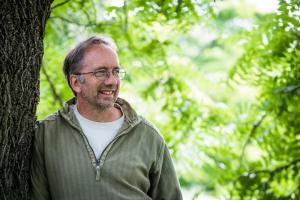 Civic engagement is something people tend to take seriously at Marlboro College. Whether it’s working with Cambodian villagers to improve their drinking water or finding the resources for a skateboard ramp on campus, community members show up and make their voices heard. Marlboro attracts students who are not only academically curious but devoted to intellectual freedom, excited by our model of self-governance, and engaged in community-building.
Civic engagement is something people tend to take seriously at Marlboro College. Whether it’s working with Cambodian villagers to improve their drinking water or finding the resources for a skateboard ramp on campus, community members show up and make their voices heard. Marlboro attracts students who are not only academically curious but devoted to intellectual freedom, excited by our model of self-governance, and engaged in community-building.
This issue of Potash Hill is chock full of civic engagement, from a feature about collective action by politics professor Meg Mott to an editorial on challenging war with imagination from film professor Jay Craven. From senior Kelly Hickey’s exploration of second-wave feminism in Vermont to a timely campus celebration of the Americans with Disabilities Act, this issue is, well, full of issues.
Students meeting with trustees to discuss renewal, change, and what they value most about Marlboro—check. A panel of faculty discussing the alarming fate of North African nations in the wake of the Arab Spring—check. A new book by alumnus Charles Curtin on conserving large, complex ecological systems—yup. We even welcome two community-oriented faculty members: Nelli Sargsyan, who explores the anthropology of social movements, and Roberto Lugo, who uses ceramics to challenge cultural intolerance. You can find it all in this action-packed Potash Hill.
In the words of President Kevin, who joined our community in July 2015 and has not sat idle for five minutes since, colleges like Marlboro “prepare individuals for thoughtful, purposeful, and effective engagement in the world” (Potash Hill, Fall 2015). The Renaissance Scholars program he initiated last year, with the eager support of the community, is making it easier to find the “rugged intellectuals” that will be actively engaged on campus and in the world. Learn more at goo.gl/vFgohZ.
What are you doing to “think outside the cave?” Where has your “road less traveled” led you, and where are you leading your community? We are eager to hear your responses to this issue, and your own stories of engagement.
—Philip Johansson, editor
Inside Front Cover
Potash Hill
Published twice every year, Potash Hill shares highlights of what Marlboro College community members, in both undergraduate and graduate programs, are doing, creating, and thinking. The publication is named after the hill in Marlboro, Vermont, where the undergraduate campus was founded in 1946. “Potash,” or potassium carbonate, was a locally important industry in the 18th and 19th centuries, obtained by leaching wood ash and evaporating the result in large iron pots. Students and faculty at Marlboro no longer make potash, but they are very industrious in their own way, as this publication amply demonstrates.
Editor: Philip Johansson
Photo Editor: Ella McIntosh
Staff Photographers: Ben Rybisky ’18 and Lindsay Stevens ’17
Design: New Ground Creative
Potash Hill welcomes letters to the editor. Mail them to: Editor, Potash Hill, Marlboro College, P.O. Box A, Marlboro, VT 05344, or send email to pjohansson@marlboro.edu. The editor reserves the right to edit for length letters that appear in Potash Hill.
Front Cover: A massive, welded sculpture by Colin Leon ’15, part of his Plan show in December 2015, gives a palpable sense of opposing forces, dynamic balance, and engagement. Learn about Colin’s recent work on a kinetic sculpture at Burning Man 2015 on page 28.
The class of 2015 put their money where their mouths enjoyed copious cappuccinos and deep-fried comfort food, with a class gift of new stools for the renovated campus center coffee shop, known as “Potash Grill.” Stop by whenever you have a hankering for a hummus wrap or a maple latte. Or see a recent video about the coffee shop by student Matteo Lanzarotta ’18.
About Marlboro College
Marlboro College provides independent thinkers with exceptional opportunities to broaden their intellectual horizons, benefit from a small and close-knit learning community, establish a strong foundation for personal and career fulfillment, and make a positive difference in the world. At our undergraduate campus in the town of Marlboro, Vermont, and our graduate center in Brattleboro, students engage in deep exploration of their interests—and discover new avenues for using their skills to improve their lives and benefit others—in an atmosphere that emphasizes critical and creative thinking, independence, an egalitarian spirit, and community.
Up Front
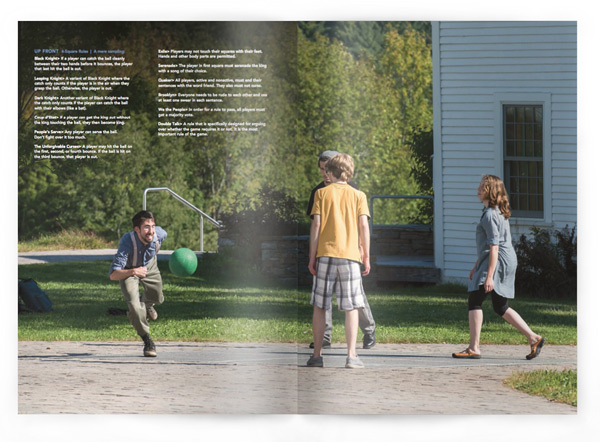
4-Square Rules | A mere sampling:
Black Knight> If a player can catch the ball cleanly between their two hands before it bounces, the player that last hit the ball is out.
Leaping Knight> A variant of Black Knight where the catch only counts if the player is in the air when they grasp the ball. Otherwise, the player is out.
Dark Knight> Another variant of Black Knight where the catch only counts if the player can catch the ball with their elbows (like a bat).
Coup d’Etat> If a player can get the king out without the king touching the ball, they then become king.
People’s Serve> Any player can serve the ball. Don’t fight over it too much.
The Unforgivable Curses> A player may hit the ball on the first, second, or fourth bounce. If the ball is hit on the third bounce, that player is out.
Exile> Players may not touch their squares with their feet. Hands and other body parts are permitted.
Serenade> The player in first square must serenade the king with a song of their choice.
Quaker> All players, active and nonactive, must end their sentences with the word friend. They also must not curse.
Brooklyn> Everyone needs to be rude to each other and use at least one swear in each sentence.
We the People> In order for a rule to pass, all players must get a majority vote.
Double Talk> A rule that is specifically designed for arguing over whether the game requires it or not. It is the most important rule of the game.
Clear Writing
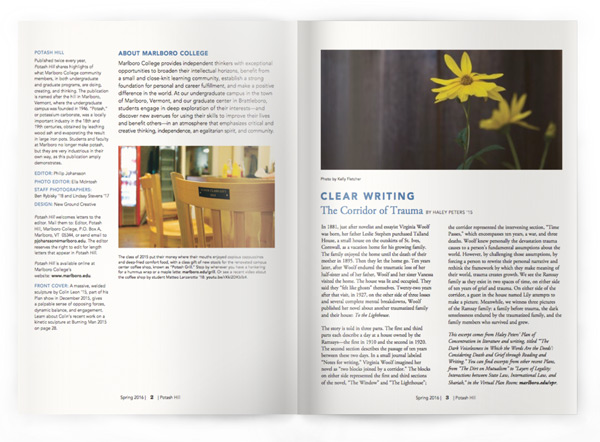
The Corridor of Trauma
By Haley Peters ’15
In 1881, just after novelist and essayist Virginia Woolf was born, her father Leslie Stephen purchased Talland House, a small house on the outskirts of St. Ives, Cornwall, as a vacation home for his growing family. The family enjoyed the home until the death of their mother in 1895. Then they let the home go. Ten years later, after Woolf endured the traumatic loss of her half-sister and of her father, Woolf and her sister Vanessa visited the home. The house was lit and occupied. They said they “felt like ghosts” themselves. Twenty-two years after that visit, in 1927, on the other side of three losses and several complete mental breakdowns, Woolf published her novel about another traumatized family and their house: To the Lighthouse.
The story is told in three parts. The first and third parts each describe a day at a house owned by the Ramsays—the first in 1910 and the second in 1920. The second section describes the passage of ten years between these two days. In a small journal labeled “Notes for writing,” Virginia Woolf imagined her novel as “two blocks joined by a corridor.” The blocks on either side represented the first and third sections of the novel, “The Window” and “The Lighthouse”; the corridor represented the intervening section, “Time Passes,” which encompasses ten years, a war, and three deaths. Woolf knew personally the devastation trauma causes to a person’s fundamental assumptions about the world. However, by challenging those assumptions, by forcing a person to rewrite their personal narrative and rethink the framework by which they make meaning of their world, trauma creates growth. We see the Ramsay family as they exist in two spaces of time, on either side of ten years of grief and trauma. On either side of the corridor, a guest in the house named Lily attempts to make a picture. Meanwhile, we witness three pictures of the Ramsay family: a family before trauma, the dark senselessness endured by the traumatized family, and the family members who survived and grew.
This excerpt comes from Haley Peters’ Plan of Concentration in literature and writing, titled “‘The Dark Voicelessness in Which the Words Are the Deeds’: Considering Death and Grief through Reading and Writing.” You can find excerpts from other recent Plans, from “The Dirt on Mutualism” to “Layers of Legality: Interactions between State Law, International Law, and Shariah,” in the Virtual Plan Room. Photo by Kelly Fletcher
Letters
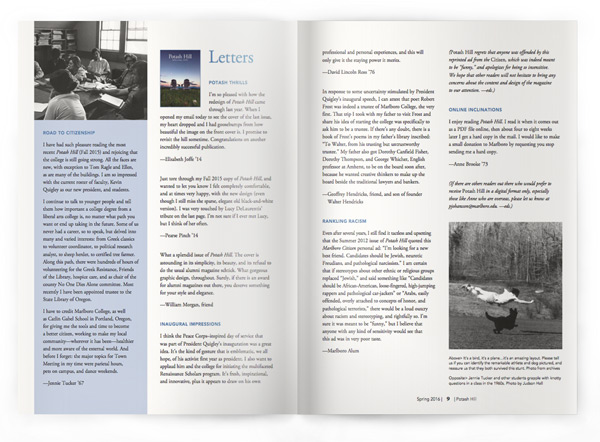
Road to Citizenship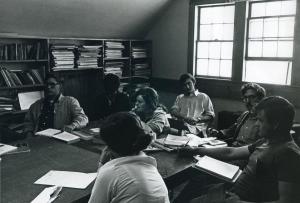 I have had such pleasure reading the most recent Potash Hill (Fall 2015) and rejoicing that the college is still going strong. All the faces are new, with exception to Tom Ragle and Ellen, as are many of the buildings. I am so impressed with the current roster of faculty, Kevin Quigley as our new president, and students.
I have had such pleasure reading the most recent Potash Hill (Fall 2015) and rejoicing that the college is still going strong. All the faces are new, with exception to Tom Ragle and Ellen, as are many of the buildings. I am so impressed with the current roster of faculty, Kevin Quigley as our new president, and students.
I continue to talk to younger people and tell them how important a college degree from a liberal arts college is, no matter what path you want or end up taking in the future. Some of us never had a career, so to speak, but delved into many and varied interests: from Greek classics to volunteer coordinator, to political research analyst, to sheep herder, to certified tree farmer. Along this path, there were hundreds of hours of volunteering for the Greek Resistance, Friends of the Library, hospice care, and as chair of the county No One Dies Alone committee. Most recently I have been appointed trustee to the State Library of Oregon.
I have to credit Marlboro College, as well as Catlin Gabel School in Portland, Oregon, for giving me the tools and time to become a better citizen, working to make my local community—wherever it has been—healthier and more aware of the external world. And before I forget: the major topics for Town Meeting in my time were parietal hours, pets on campus, and dance weekends.
—Jennie Tucker ’67
Potash Thrills
I’m so pleased with how the redesign of Potash Hill came through last year. When I opened my email today to see the cover of the last issue, my heart dropped and I had goosebumps from how beautiful the image on the front cover is. I promise to revisit the hill sometime. Congratulations on another incredibly successful publication.
—Elisabeth Joffe ’14
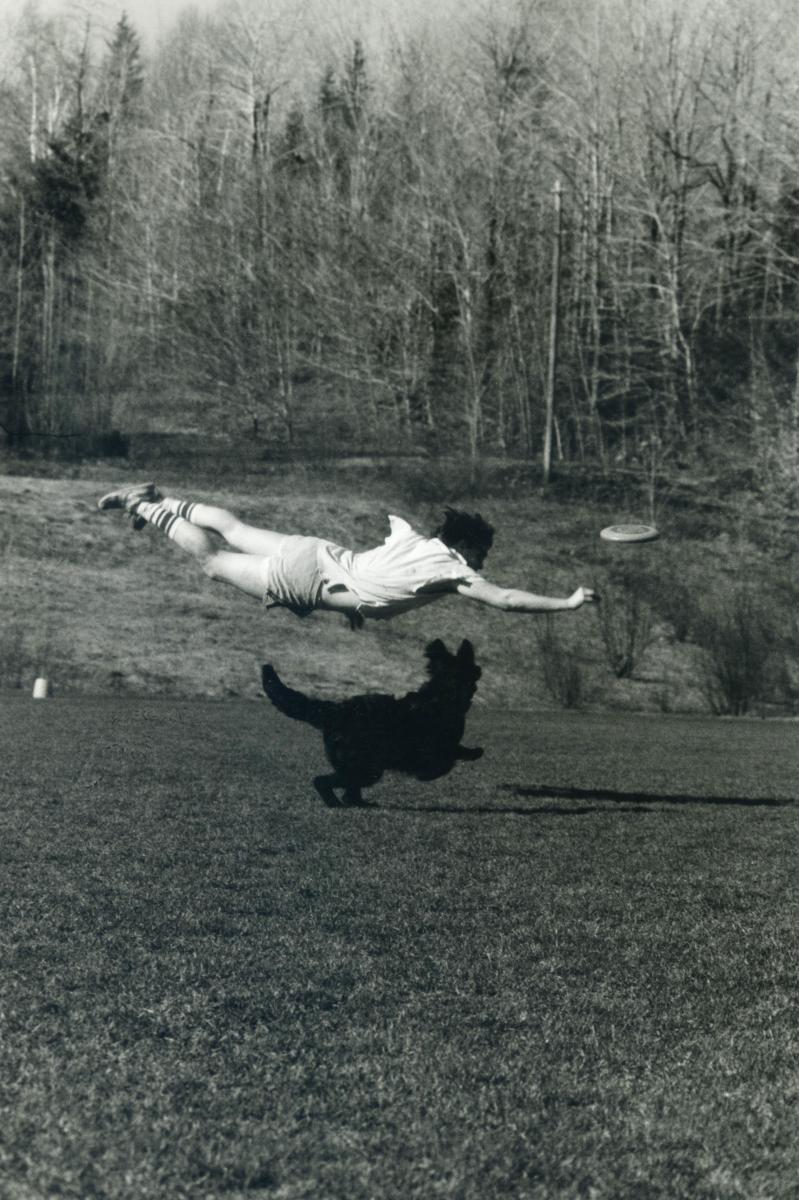 Just tore through my Fall 2015 copy of Potash Hill, and wanted to let you know I felt completely comfortable, and at times very happy, with the new design (even though I still miss the sparse, elegant old black-and-white version). I was very touched by Lucy DeLaurentis’ tribute on the last page. I’m not sure if I ever met Lucy, but I think of her often.
Just tore through my Fall 2015 copy of Potash Hill, and wanted to let you know I felt completely comfortable, and at times very happy, with the new design (even though I still miss the sparse, elegant old black-and-white version). I was very touched by Lucy DeLaurentis’ tribute on the last page. I’m not sure if I ever met Lucy, but I think of her often.
—Pearse Pinch ’14
What a splendid issue of Potash Hill. The cover is astounding in its simplicity, its beauty, and its refusal to do the usual alumni magazine schtick. What gorgeous graphic design, throughout. Surely, if there is an award for alumni magazines out there, you deserve something for your style and elegance.
—William Morgan, friend
Inaugural Impressions
I think the Peace Corps–inspired day of service that was part of President Quigley’s inauguration was a great idea. It’s the kind of gesture that is emblematic, we all hope, of his activist first year as president. I also want to applaud him and the college for initiating the multifaceted Renaissance Scholars program. It’s fresh, inspirational, and innovative, plus it appears to draw on his own professional and personal experiences, and this will only give it the staying power it merits.
—David Lincoln Ross ’76
In response to some uncertainty stimulated by President Quigley’s inaugural speech, I can attest that poet Robert Frost was indeed a trustee of Marlboro College, the very first. That trip I took with my father to visit Frost and share his idea of starting the college was specifically to ask him to be a trustee. If there’s any doubt, there is a book of Frost’s poems in my father’s library inscribed: “To Walter, from his trusting but untrustworthy trustee.” My father also got Dorothy Canfield Fisher, Dorothy Thompson, and George Whicher, English professor at Amherst, to be on the board soon after, because he wanted creative thinkers to make up the board beside the traditional lawyers and bankers.
— Geoffrey Hendricks, friend, and son of founder Walter Hendricks
Rankling Racism
Even after several years, I still find it tactless and upsetting that the Summer 2012 issue of Potash Hill quoted this Marlboro Citizen personal ad: “I’m looking for a new best friend. Candidates should be Jewish, neurotic Freudians, and pathological narcissists.” I am certain that if stereotypes about other ethnic or religious groups replaced “Jewish,” and said something like “Candidates should be African-American, loose-fingered, high-jumping rappers and pathological car-jackers” or “Arabs, easily offended, overly attached to concepts of honor, and pathological terrorists,” there would be a loud outcry about racism and stereotyping, and rightfully so. I’m sure it was meant to be “funny,” but I believe that anyone with any kind of sensitivity would see that this ad was in very poor taste.
—Marlboro Alum
(Potash Hill regrets that anyone was offended by this reprinted ad from the Citizen, which was indeed meant to be “funny,” and apologizes for being so insensitive. We hope that other readers will not hesitate to bring any concerns about the content and design of the magazine to our attention. —eds.)
Online Inclinations
I enjoy reading Potash Hill. I read it when it comes out as a PDF file online, then about four to eight weeks later I get a hard copy in the mail. I would like to make a small donation to Marlboro by requesting you stop sending me a hard copy.
—Anne Brooke ’73
(If there are others readers out there who would prefer to receive Potash Hill in a digital format only, especially those like Anne who are overseas, please let us know at pjohansson@marlboro.edu. —eds.)
Thinking Against the Machine
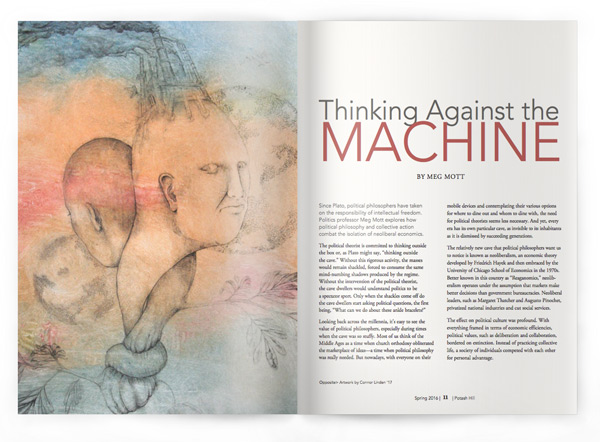
By Meg Mott
 Since Plato, political philosophers have taken on the responsibility of intellectual freedom. Politics professor Meg Mott explores how political philosophy and collective action combat the isolation of neoliberal economics.
Since Plato, political philosophers have taken on the responsibility of intellectual freedom. Politics professor Meg Mott explores how political philosophy and collective action combat the isolation of neoliberal economics.
The political theorist is committed to thinking outside the box or, as Plato might say, “thinking outside the cave.” Without this rigorous activity, the masses would remain shackled, forced to consume the same mind-numbing shadows produced by the regime. Without the intervention of the political theorist, the cave dwellers would understand politics to be a spectator sport. Only when the shackles come off do the cave dwellers start asking political questions, the first being, “What can we do about these ankle bracelets?”
Looking back across the millennia, it’s easy to see the value of political philosophers, especially during times when the cave was so stuffy. Most of us think of the Middle Ages as a time when church orthodoxy obliterated the marketplace of ideas—a time when political philosophy was really needed. But nowadays, with everyone on their mobile devices and contemplating their various options for where to dine out and whom to dine with, the need for political theorists seems less necessary. And yet, every era has its own particular cave, as invisible to its inhabitants as it is dismissed by succeeding generations.
The relatively new cave that political philosophers want us to notice is known as neoliberalism, an economic theory developed by Friedrich Hayek and then embraced by the University of Chicago School of Economics in the 1970s. Better known in this country as “Reaganomics,” neoliberalism operates under the assumption that markets make better decisions than government bureaucracies. Neoliberal leaders, such as Margaret Thatcher and Augusto Pinochet, privatized national industries and cut social services.
The effect on political culture was profound. With everything framed in terms of economic efficiencies, political values, such as deliberation and collaboration, bordered on extinction. Instead of practicing collective life, a society of individuals competed with each other for personal advantage.
Neoliberalism rewrote the metaphor of the cave: instead of looking at the same shadows on the wall, each cave dweller is fixated on their individual screen. At least in the ancient cave we might have rolled our collective eyes at the stupidity of the protagonist or found ourselves weeping in unison. Even the industrialized cave, described by Marx, provided the basis for a common experience. Once the workers saw how they were each alienated from their labor, they would rise up and demand better conditions in the cave. By making us think that our natural condition is separate, neoliberalism destroys the very possibility for collective action. Under neoliberalism, we aren’t just alienated from our labor. Rather, the I is alienated from the We.
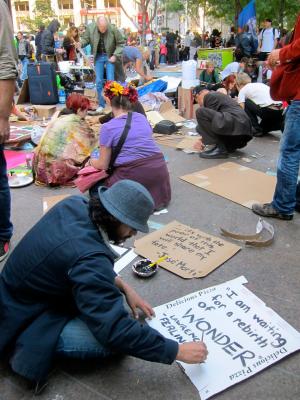 Michel Foucault was one of the first political philosophers to raise the alarm about these new conditions. In a series of lectures in the late 1970s he spoke about a type of power that used “techniques oriented towards individuals and intended to rule them in a continuous and permanent way.” This “pastoral power” wasn’t an entirely new way of organizing the masses: Christian kings had used it successfully for centuries to guide their flock. However, when pastoral power was combined with market rationality the result was dangerously antipolitical. Where the medieval rulers moved the flock toward a shared and blessed future, the neoliberal rulers moved each member into total isolation.
Michel Foucault was one of the first political philosophers to raise the alarm about these new conditions. In a series of lectures in the late 1970s he spoke about a type of power that used “techniques oriented towards individuals and intended to rule them in a continuous and permanent way.” This “pastoral power” wasn’t an entirely new way of organizing the masses: Christian kings had used it successfully for centuries to guide their flock. However, when pastoral power was combined with market rationality the result was dangerously antipolitical. Where the medieval rulers moved the flock toward a shared and blessed future, the neoliberal rulers moved each member into total isolation.
Since Foucault’s time, the situation has become even more dire. According to contemporary political theorist Wendy Brown, entire “vocabularies, principles of justice, political cultures, habits of citizenship, practices of rules, and above all, democratic imaginaries” are slipping away. Political questions such as “What do we need to improve our neighborhoods?” have been displaced by “How can I get ahead?” With all aspects of existence described in individual terms, we can’t see ourselves as anything but isolated players in a highly competitive game. This is even true in higher education, argues Brown, where college administrators have abandoned political conceptions of life for the metrics of the marketplace.
Brown’s concerns are well founded. Under the Obama Administration, colleges and universities are required to report average student debt and expected earnings for their graduates. It makes sense, then, that college students would come to see themselves in purely economic terms. Who can afford to invest their time reading Plato or Foucault? The denizens of the neoliberal college do not have the leisure to think politically, but must figure out the cost and benefits of studying a particular major.
It would appear that we have become the very society that Foucault predicted would emerge under neoliberal policies. “We are at the civilizational turning point that neoliberal rationality marks,” concludes Brown, pointing to its deep antihumanism and surrender to a condition of human impotence. Normally, this would be a time when political philosophy flew in for the rescue, but with so few undergraduates investing their time in political theory, who will free us now? Has political philosophy finally met its match under neoliberalism?
While I share Foucault’s and Brown’s concerns, I’m too much a student of Aristotle to cede our natural political instincts. Even in this era of handheld devices and precarious economics, collective political action has not been erased. If anything, we’re seeing an upswing in democratic action, such as Occupy Wall Street and Black Lives Matter. The individuals who participate in these social movements are not alienated from each other but are compelled to act together. They find themselves having to organize themselves and make collective decisions. The conditions of the neoliberal cave, like the conditions of Marx’s capitalist cave, provoke a social response.
Black Lives Matter, for example, has used the conditions of police violence against unarmed black persons to organize toward greater political action. By challenging police violence, Black Lives Matter threatens the most invidious quality of neoliberalism: the process of individualization, when each person is obsessed with his or her isolated screen. When everyone’s eyes are on the same disturbing event, the audience discovers its power. Earlier protests expressed outrage at what the state was doing, with calls like “No justice, no peace.” As the group realized its strength, the line shifted to Kendrick Lamar’s “We’re gonna be alright.” Like Marx’s proletariat, protestors began by focusing on what was being done to them and then began imagining what they could do for themselves.
If social movements respond to real world events, not to lectures delivered by erudite philosophers in refined auditoriums, why do we need political philosophy?
Political theory’s enduring contribution is its capacity to step out of an existing framework and offer a different set of values. As my dissertation advisor Nick Xenos recently said, political theorists do not study the Thing. We study the Thing behind the Thing. In other words, we study the Thing that runs the projector. Where social movements organize around the disturbing events on the screen, political theory asks, “What does police violence tell us about the crisis of capitalism?” We study patterns of control across centuries in order to assess the current manifestations. We study the past so that we can think beyond the syntax of the present.
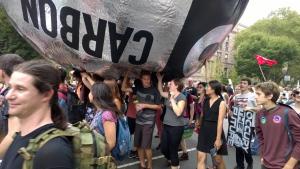 Political theory becomes crucial when social movements are asked to speak to the larger public. This is particularly true of Occupy Wall Street, which is often dismissed for not having achieved any goals. Looked at from the rubric of neoliberalism, where success is defined as “meeting one’s objective,” OWS clearly failed. But explored under the values of democratic philosophy, where success means developing political habits and enlarging a group’s political imagination, OWS clearly succeeded.
Political theory becomes crucial when social movements are asked to speak to the larger public. This is particularly true of Occupy Wall Street, which is often dismissed for not having achieved any goals. Looked at from the rubric of neoliberalism, where success is defined as “meeting one’s objective,” OWS clearly failed. But explored under the values of democratic philosophy, where success means developing political habits and enlarging a group’s political imagination, OWS clearly succeeded.
Even with groups with clearly articulated goals, such as Black Lives Matter, social movements run the risk of winning battles and losing the war. If community policing is instituted in this country, it will need a different set of principles than were developed under neoliberalism. Most of the tough tactics used by police were developed with the support of black leaders in black neighborhoods that were being destroyed by drug use and crime. These community leaders, like all leaders operating in the cave known as the War on Drugs, believed what the screen told them to believe: that crime was the result of individual actions and personal choices. Black Lives Matter may reject those principles but they need other vocabularies and political imaginaries, to quote Wendy Brown, to explain those noneconomic principles.
In fact, many of the organizers of Black Lives Matter are doing what the organizers of the Civil Rights Movement did: they are developing political habits. They are meeting in church basements and role-playing encounters with the police, who are afraid of getting hurt; and homeowners, who are afraid of riot; and business owners, who are afraid of looting. Building on the lessons learned by Freedom Riders in the 1960s and AIDS activists in the 1980s and other nonviolent organizers who use creativity and imagination to resist the logic of the marketplace, organizers in Black Lives Matter are increasing our collective capacity for democratic action. And while the habits are themselves liberating, one still needs the political principles to anchor these habits outside the cave.
Political theorizing, a capacity we all share, reminds us that we can think beyond the logic of whatever rationality is keeping us shackled to the shadows of the day. Even the tightly ordered neoliberal cave, with its insistent demands for productivity and efficiency, will not keep us from our political natures. The world reliably gives us the conditions to be more than the sum of our individual anxieties. We just need to see ourselves as political actors: the sort of people who know that what they create is infinitely more interesting than anything being projected on the screen.
Meg Mott teaches political theory at Marlboro and is director of Speech Matters, a semester intensive that investigates a single issue through the many ways it is talked about (see Fall 2015 Potash Hill).
Up from Substance Use Prevention
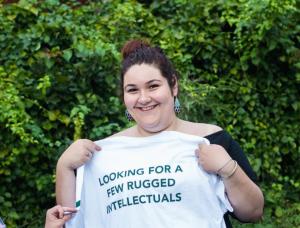 “If you come in from a perspective of ‘this substance will only destroy your life’ you are creating an environment of shame—you are only keeping people further disconnected,” said sophomore Ariana Rodrigues-Juarbe, a student in Speech Matters last fall. She presented her final project, a ‘zine on how we talk about substance use in our society, at a public forum by eight students from the semester intensive at the Marlboro College Graduate Center in December. Ariana’s emphasis is on turning “prevention into comprehension,” or to take Meg’s metaphor one step further, to step outside the cave of “Just Say No.” “It all came together with the idea that if we want to actually address substance use, we have to understand that not everyone is coming from the same place, both in how they use, and in what that use means in their life,” said Ariana. See video excerpts from the public forum.
“If you come in from a perspective of ‘this substance will only destroy your life’ you are creating an environment of shame—you are only keeping people further disconnected,” said sophomore Ariana Rodrigues-Juarbe, a student in Speech Matters last fall. She presented her final project, a ‘zine on how we talk about substance use in our society, at a public forum by eight students from the semester intensive at the Marlboro College Graduate Center in December. Ariana’s emphasis is on turning “prevention into comprehension,” or to take Meg’s metaphor one step further, to step outside the cave of “Just Say No.” “It all came together with the idea that if we want to actually address substance use, we have to understand that not everyone is coming from the same place, both in how they use, and in what that use means in their life,” said Ariana. See video excerpts from the public forum.
Green Mountain Feminism
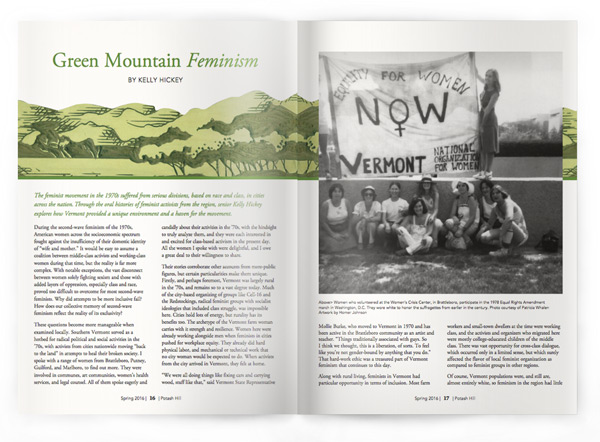
By Kelly Hickey
The feminist movement in the 1970s suffered from serious divisions, based on race and class, in cities across the nation. Through the oral histories of feminist activists from the region, senior Kelly Hickey explores how Vermont provided a unique environment and a haven for the movement.
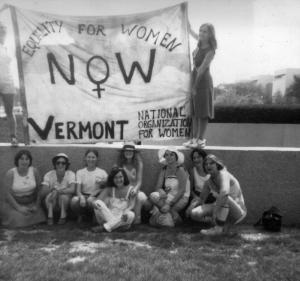 During the second-wave feminism of the 1970s, American women across the socioeconomic spectrum fought against the insufficiency of their domestic identity of “wife and mother.” It would be easy to assume a coalition between middle-class activists and working-class women during that time, but the reality is far more complex. With notable exceptions, the vast disconnect between women solely fighting sexism and those with added layers of oppression, especially class and race, proved too difficult to overcome for most second-wave feminists. Why did attempts to be more inclusive fail? How does our collective memory of second-wave feminism reflect the reality of its exclusivity?
During the second-wave feminism of the 1970s, American women across the socioeconomic spectrum fought against the insufficiency of their domestic identity of “wife and mother.” It would be easy to assume a coalition between middle-class activists and working-class women during that time, but the reality is far more complex. With notable exceptions, the vast disconnect between women solely fighting sexism and those with added layers of oppression, especially class and race, proved too difficult to overcome for most second-wave feminists. Why did attempts to be more inclusive fail? How does our collective memory of second-wave feminism reflect the reality of its exclusivity?
These questions become more manageable when examined locally. Southern Vermont served as a hotbed for radical political and social activities in the ’70s, with activists from cities nationwide moving “back to the land” in attempts to heal their broken society. I spoke with a range of women from Brattleboro, Putney, Guilford, and Marlboro, to find out more. They were involved in communes, art communities, women’s health services, and legal counsel. All of them spoke eagerly and candidly about their activities in the ’70s, with the hindsight to truly analyze them, and they were each interested in and excited for class-based activism in the present day. All the women I spoke with were delightful, and I owe a great deal to their willingness to share.
Their stories corroborate other accounts from more-public figures, but certain particularities make them unique. Firstly, and perhaps foremost, Vermont was largely rural in the ’70s, and remains so to a vast degree today. Much of the city-based organizing of groups like Cell-16 and the Redstockings, radical feminist groups with socialist ideologies that included class struggle, was impossible here. Cities hold lots of energy, but rurality has its benefits too. The archetype of the Vermont farm woman carries with it strength and resilience. Women here were already working alongside men when feminists in cities pushed for workplace equity. They already did hard physical labor, and mechanical or technical work that no city woman would be expected to do. When activists from the city arrived in Vermont, they felt at home.
“We were all doing things like fixing cars and carrying wood, stuff like that,” said Vermont State Representative Mollie Burke, who moved to Vermont in 1970 and has been active in the Brattleboro community as an artist and teacher. “Things traditionally associated with guys. So I think we thought, this is a liberation, of sorts. To feel like you’re not gender-bound by anything that you do.” That hard-work ethic was a treasured part of Vermont feminism that continues to this day.
Along with rural living, feminists in Vermont had particular opportunity in terms of inclusion. Most farm workers and small-town dwellers at the time were working class, and the activists and organizers who migrated here were mostly college-educated children of the middle class. There was vast opportunity for cross-class dialogue, which occurred only in a limited sense, but which surely affected the flavor of local feminist organization as compared to feminist groups in other regions.
Of course, Vermont populations were, and still are, almost entirely white, so feminism in the region had little to deal with in terms of racial tension. The lack of racial diversity couldn’t be considered an asset to any burgeoning social movement, but it is a fact that influenced the way women’s liberation organizations were run. Instead of hearing directly from women of color, in many cases Vermont feminists had to sympathize from afar with situations quite removed from their daily lives. Isolation could be difficult in other ways, as women in rural Vermont had fewer interactions with other politically active women than did women living in, say, New York.
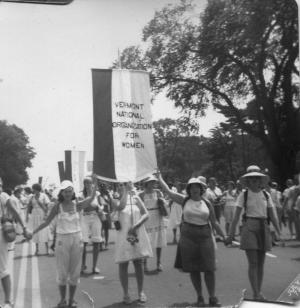 Feminist women in rural Vermont certainly lived a different existence than many city-based feminists in the ’70s. Those who could afford to attend conferences and trainings elsewhere, those who could spend time and money on higher education, and those in professional networks kept the rest of the women connected to feminist movements across the nation. In Vermont, as in other rural areas, the middle class served as the links in a network of poor or otherwise marginalized women.
Feminist women in rural Vermont certainly lived a different existence than many city-based feminists in the ’70s. Those who could afford to attend conferences and trainings elsewhere, those who could spend time and money on higher education, and those in professional networks kept the rest of the women connected to feminist movements across the nation. In Vermont, as in other rural areas, the middle class served as the links in a network of poor or otherwise marginalized women.
Certain issues in particular did ignite cross-class coalition among women. One of the most serious and significant of these was violence against women. The Women’s Crisis Center in Brattleboro, and presumably other women’s health clinics around the country, provided safe space for women to talk about their abuse, their fears, and their needs. Women realized that domestic violence was an issue for all of them, regardless of background.
The Honorable Patricia Whalen is a local judge who founded the Rural Women Leadership Institute of Vermont and served on the International Criminal Tribunal for Bosnia. In the ’70s, Patti worked at the Women’s Crisis Center, which she helped found, providing legal aid to low-income women. She described one incident where a wealthy woman with beautiful clothes came to the center, and the other women resented her right away. She was very attractive and had no outward signs of being beaten like the others.
“She said, ‘Yeah, you’re right. My husband would never do that to me, because he would never want the public to see that he hit me,’” recounted Patti. “And then she just pushed her sleeve up, and she said, ‘No, he just put his cigarettes out on me all the time.’ She was just horribly burned and scarred. And the women were like, ‘Holy crap, my husband never did that to me. Wait a minute, that’s, like, really bad.’ And so there was always common ground found in stuff.”
As these crisis centers started to use consciousness-raising circles as healing spaces for women, more cross-class interactions and sympathies became possible. Violence against women is more prevalent in lower economic brackets, and working-class women also tend to need more legal assistance and time in shelters after leaving abusive partners. But while most of the long-term clients of the crisis center were working-class women, middle-class and wealthy women who visited the clinic for shorter-term support were able to participate in an open and honest cross-class dialogue.
Abortion rights groups and advocates of accessible birth control options also managed to initiate dialogue across class lines, as unwanted pregnancy and family planning are issues with which all sorts of women can identify.
In the end, however, working-class women still didn’t have even close to the options of their middle-class sisters. Mollie Burke experienced the radical ’70s as more of a personal evolution than a group consciousness-raising. Her story of working in a male-dominated, blue-collar environment epitomizes the difference between working-class women and the educated middle class, even in Vermont.
“I worked as a waitress, briefly. I was a terrible waitress,” said Mollie, laughing. “There were other women who worked at this restaurant, that no longer exists, and one woman had six children. And the kid, who was the son of the owner, would boss these women around, and call them ‘girls.’ I mean, it was horrible. But I could get out, you know. They needed to stay.” And truly, education was the pith of it. Many of these activists had no more money than the women they worked alongside and for, but they had the family and educational safety nets to change course when necessary.
 In her work at the Women’s Crisis Center and in the region, Patti Whalen has had an intimate perspective on the divergence between poor women and middle-class feminists. She described a shift in consciousness of the middle-class volunteers at the center, from collaborating with low-income feminists to fighting for their own issues.
In her work at the Women’s Crisis Center and in the region, Patti Whalen has had an intimate perspective on the divergence between poor women and middle-class feminists. She described a shift in consciousness of the middle-class volunteers at the center, from collaborating with low-income feminists to fighting for their own issues.
“I think everybody understood, in a way, that we were going to get a seat at the table,” said Patti. “And then when we got a seat at the table, we were all of a sudden going to chair the table.”
The activists who flocked to Vermont to eschew society in the early ’70s realized their potential power—as members of that very same structure. Patti went on to name women she worked with, women who moved on to run nonprofit organizations, who serve in the legislature, who work for other leading activists and politicians. The welfare fight wasn’t being won, and middle-class feminists developed other priorities. They turned to the Equal Rights Amendment with full force, and the failure to ratify that bill stymied any further momentum across classes.
International women’s rights movements began to pick up at the end of the decade, with more frequent UN conferences and greater popular awareness of rights violations around the world. Issues like child brides and female genital mutilation were easy to oppose for American women across class lines. Yet even in Vermont, which had its unique chapter in the history of feminism, it seems this international outreach has done little to unite women across classes on national feminist issues.
Kelly Hickey is a senior at Marlboro working on a Plan of Concentration in oral history and visual arts. This article is excerpted from a paper that is a work in progress toward Kelly’s Plan, originally written for the Politics of Change class.
Radicals in These Hills
Kelly and other Marlboro students presented their oral history projects in a public event at the Campus Center in December, titled “Radicals in These Hills,” the culmination of their course Politics of Change: Radical Movements of the Late 20th Century. Taught by theater professor Brenda Foley and American studies professor Kate Ratcliff, the class was part of a pilot for a far-reaching collaborative project produced by Vermont Performance Lab (VPL), in partnership with Green Mountain Crossroads (GMC) and the Rockingham Arts and Museum Project. This partnership is supported by the National Endowment for the Arts and the Samara Fund of the Vermont Community Foundation. VPL theater artist Ain Gordon and HB Lozito of GMC co-directed the class, and many of the oral histories were made possible by VPL’s connections to the local community. “The class is part of a larger vision for a Center for Performing Arts and Social Practice that links coursework and community engagement with VPL artists’ research,” says Sara Coffey ’90, VPL founder and director. “One of the many things we hope to create is an archive on local radical movements, a resource for the broader community that will include students’ work, oral histories, and archival materials.” See a video of the whole event.
Small Town Pride
“The Andrews Inn appears to be Vermont’s answer to the Stonewall Inn, a haven for LGBTQ people to be out and proud, to socialize, be free, have sex,” says senior Rainbow Stakiwicz (pictured with interviewee Eva Mondon), a student in last fall’s Politics of Change class. She did her oral history project on the Bellows Falls gay bar, which thrived through “the long 1970s” until closing in 1982 under mysterious circumstances. “It lives in legend and lore, but its life is largely undocumented, considering that it was well known all along the East Coast.” With the help of Robert McBride of the Rockingham Arts and Museum Project and Vermont Performance Lab, Rainbow was able to speak to some of the patrons who are still around. They remember the inn with fondness as a place where they could express themselves at a time when, in most places, they could not. Her project culminated in a short piece of theater based on her findings. See a video of a reading.
War Talk
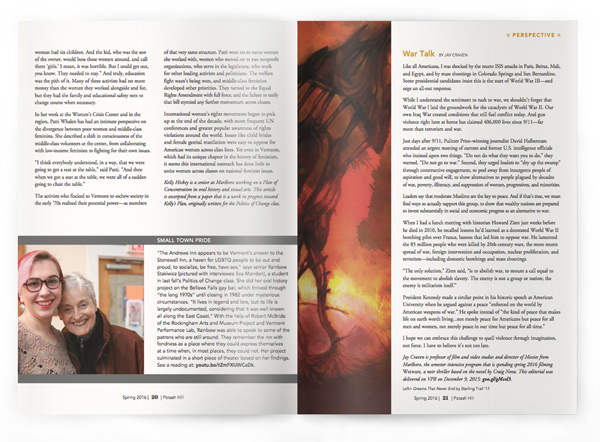
By Jay Craven
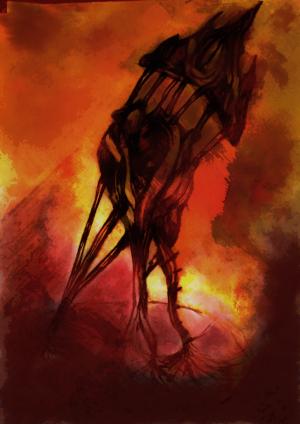 Like all Americans, I was shocked by the recent ISIS attacks in Paris, Beirut, Mali, and Egypt, and by mass shootings in Colorado Springs and San Bernardino. Some presidential candidates insist this is the start of World War III—and urge an all-out response.
Like all Americans, I was shocked by the recent ISIS attacks in Paris, Beirut, Mali, and Egypt, and by mass shootings in Colorado Springs and San Bernardino. Some presidential candidates insist this is the start of World War III—and urge an all-out response.
While I understand the sentiment to rush to war, we shouldn’t forget that World War I laid the groundwork for the cataclysm of World War II. Our own Iraq War created conditions that still fuel conflict today. And gun violence right here at home has claimed 406,000 lives since 9/11—far more than terrorism and war.
Just days after 9/11, Pulitzer Prize–winning journalist David Halberstam attended an urgent meeting of current and former U.S. intelligence officials who insisted upon two things. “Do not do what they want you to do,” they warned. “Do not go to war.” Second, they urged leaders to “dry up the swamp” through constructive engagement, to peel away from insurgents people of aspiration and good will, to show alternatives to people plagued by decades of war, poverty, illiteracy, and suppression of women, progressives, and minorities.
Leaders say that moderate Muslims are the key to peace. And if that’s true, we must find ways to actually support this group, to show that wealthy nations are prepared to invest substantially in social and economic progress as an alternative to war.
When I had a lunch meeting with historian Howard Zinn just weeks before he died in 2010, he recalled lessons he’d learned as a decorated World War II bombing pilot over France, lessons that led him to oppose war. He lamented the 85 million people who were killed by 20th-century wars, the more recent spread of war, foreign intervention and occupation, nuclear proliferation, and terrorism—including domestic bombings and mass shootings.
“The only solution,” Zinn said, “is to abolish war, to mount a call equal to the movement to abolish slavery. The enemy is not a group or nation; the enemy is militarism itself.”
President Kennedy made a similar point in his historic speech at American University when he argued against a peace “enforced on the world by American weapons of war.” He spoke instead of “the kind of peace that makes life on earth worth living...not merely peace for Americans but peace for all men and women, not merely peace in our time but peace for all time.”
I hope we can embrace this challenge to quell violence through imagination, not force. I have to believe it’s not too late.
Jay Craven is professor of film and video studies and director of Movies from Marlboro, the semester intensive program that is spending spring 2016 filming Wetware, a noir thriller based on the novel by Craig Nova. This editorial was delivered on VPR on December 9, 2015.
On & Off the Hill
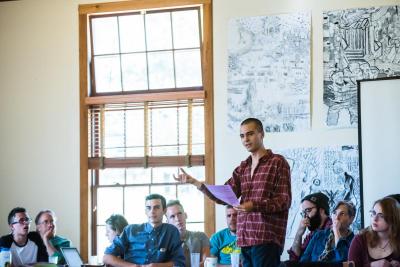
Still Worldly After All These Years, Dana Howell Retires
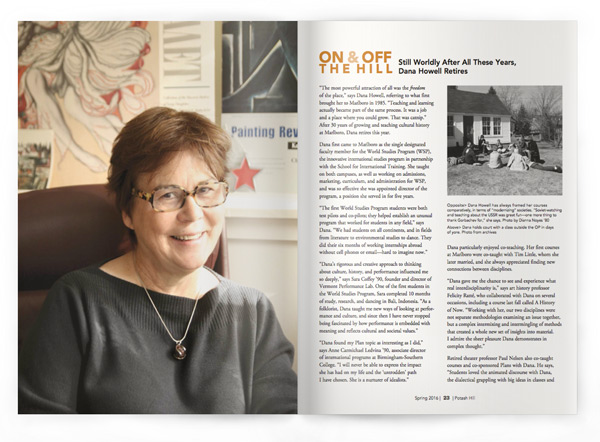
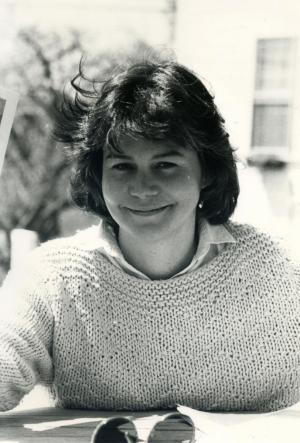 “The most powerful attraction of all was the freedom of the place,” says Dana Howell, referring to what first brought her to Marlboro in 1985. “Teaching and learning actually became part of the same process. It was a job and a place where you could grow. That was catnip.” After 30 years of growing and teaching cultural history at Marlboro, Dana retires this year.
“The most powerful attraction of all was the freedom of the place,” says Dana Howell, referring to what first brought her to Marlboro in 1985. “Teaching and learning actually became part of the same process. It was a job and a place where you could grow. That was catnip.” After 30 years of growing and teaching cultural history at Marlboro, Dana retires this year.
Dana first came to Marlboro as the single designated faculty member for the World Studies Program (WSP), the innovative international studies program in partnership with the School for International Training. She taught on both campuses, as well as working on admissions, marketing, curriculum, and administration for WSP, and was so effective she was appointed director of the program, a position she served in for five years.
“The first World Studies Program students were both test pilots and co-pilots; they helped establish an unusual program that worked for students in any field,” says Dana. “We had students on all continents, and in fields from literature to environmental studies to dance. They did their six months of working internships abroad without cell phones or email—hard to imagine now.”
“Dana’s rigorous and creative approach to thinking about culture, history, and performance influenced me so deeply,” says Sara Coffey ’90, founder and director of Vermont Performance Lab. One of the first students in the World Studies Program, Sara completed 10 months of study, research, and dancing in Bali, Indonesia. “As a folklorist, Dana taught me new ways of looking at performance and culture, and since then I have never stopped being fascinated by how performance is embedded with meaning and reflects cultural and societal values.”
“Dana found my Plan topic as interesting as I did,” says Anne Carmichael Ledvina ’90, associate director of international programs at Birmingham-Southern College. “I will never be able to express the impact she has had on my life and the ‘untrodden’ path I have chosen. She is a nurturer of idealists.” Dana particularly enjoyed co-teaching. Her first courses at Marlboro were co-taught with Tim Little, whom she later married, and she always appreciated finding new connections between disciplines.
“Dana gave me the chance to see and experience what real interdisciplinarity is,” says art history professor Felicity Ratt., who collaborated with Dana on several occasions, including a course last fall called A History of Now. “Working with her, our two disciplines were not separate methodologies examining an issue together, but a complex intermixing and intermingling of methods that created a whole new set of insights into material. I admire the sheer pleasure Dana demonstrates in complex thought.”
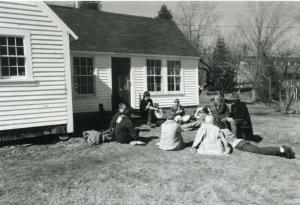 Retired theater professor Paul Nelsen also co-taught courses and co-sponsored Plans with Dana. He says, “Students loved the animated discourse with Dana, the dialectical grappling with big ideas in classes and tutorials. She deeply attached herself to the core idealism of Marlboro and was an inspirational force behind outstanding work of many students.”
Retired theater professor Paul Nelsen also co-taught courses and co-sponsored Plans with Dana. He says, “Students loved the animated discourse with Dana, the dialectical grappling with big ideas in classes and tutorials. She deeply attached herself to the core idealism of Marlboro and was an inspirational force behind outstanding work of many students.”
Literature professor Geraldine Pittman de Battle says, “Sharing Plans with Dana has meant that I have learned, and been excited by, her knowledge and her imagination. Marlboro is a hard place to get to know, but she knew immediately what a wonderful place it was and spent her entire career here keeping the ideals of Marlboro in countless ways.”
“Working with Dana was a privilege and a pivotal part of my undergraduate education,” says Colby Silver ’12, now in graduate school for international affairs at The New School. “The extent of her knowledge in a wide breadth of topics was always inspiring, and reinforced the value of a self-directed liberal arts education.”
“The thing that drew me to Dana, and the thing I admired most about her, was her way of interacting with her students,” says Amy Frazier ’06, now the film and media librarian at Middlebury College. “She’s plainspoken; you always knew that she’d tell you what she really thought. I know I presented her with some teaching challenges back in my day, but I wouldn’t be the person I am without her influence.”
“I’m always surprised by the creativity of students here, and the diversity in this small community,” says Dana, whose international perspective and wide-ranging interests allowed her to work with Plan students on a broad range of topics, from seafaring in Newfoundland to Japanese fashion. “I never know what to expect—they always think of something I haven’t. I have valued the intelligence, independent-mindedness, and irreverent humor of students at Marlboro. I will miss that.”
“Both in class, as well as in the roles of Plan sponsor and friend, Dana has displayed an innovative and inquisitive rigor that I find exhilarating and instrumental,” says one former student, now a graduate student in humanities at University of Chicago. “I continue to reap the benefits of having explored difficult lines of inquiry with her. I very much admire her ability to bring to light increasingly complex networks of cultural connections in contemporary events and thought.”
“I have always been in awe of Dana’s ability to bring together widely disparate ideas in a coherent and meaningful way,” says Kimberly Mills ’89, who went on to get her doctorate and teach anthropology for 10 years. “Dana gave me permission to be myself in the academic world. Her willingness to accept my ideas as both valid and valuable built my confidence as a scholar, and as a person, in ways that no one else has ever matched.”
Starting in 2000, Dana worked with the Open Society Institute (OSI), the international grant-making network now called Open Society Foundations. She led an evaluation team to the first liberal arts college in Russia, then served as chair of an international academic advisory committee. In that capacity she selected and supported projects for democratizing undergraduate teaching in the post-Soviet region, traveling each summer to projects from Kyrgyzstan to Croatia.
“Dana’s passion for teaching captured me, and remains something, I am convinced, that few can do so well,” says Rhett Bowlin ’93, who directed OSI’s International Higher Education Support program for nine years and recruited Dana to work with him. “With Dana I realized that I was empowered to make all kinds of consequentially positive choices in my life, for the rest of my life, including my choice to ask her to work with me.”
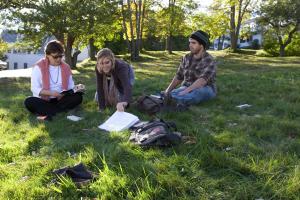 Will Jenkins ’10, who’s working on a doctoral dissertation in history at UC Berkeley, says, “Dana makes education an extended conversation. I genuinely think of my Plan as a product of our conversations over the course of two years, and even casual conversations we had in tutorials have been foundational to my academic trajectory since then. I’ve never met anyone since who treats both her subject and her students with such respect.”
Will Jenkins ’10, who’s working on a doctoral dissertation in history at UC Berkeley, says, “Dana makes education an extended conversation. I genuinely think of my Plan as a product of our conversations over the course of two years, and even casual conversations we had in tutorials have been foundational to my academic trajectory since then. I’ve never met anyone since who treats both her subject and her students with such respect.”
Dana’s plans for retirement are open. Her book The Development of Soviet Folkloristics was reissued last year by Routledge, and she plans to do some more writing. She has the usual list of “finally time for” things, like traveling to Patagonia, learning ancient Greek, and reading War and Peace in Russian.
“For several years, I’ve been focused on the normalization of war, the various presences of war in society, and the extension of war to civilians. So I am most absorbed by that at present. I don’t know how ambitious I’ll be, but I know I won’t be bored.”
Marlboro Marks ADA Anniversary
 Marlboro College celebrated the 25th anniversary of the Americans with Disabilities Act with a series of events during the first week of November. These included film screenings, talks, and discussions, as well as a campus-wide action on November 5 where community members spent a full day using walkers, wheelchairs, and other assistive devices.
Marlboro College celebrated the 25th anniversary of the Americans with Disabilities Act with a series of events during the first week of November. These included film screenings, talks, and discussions, as well as a campus-wide action on November 5 where community members spent a full day using walkers, wheelchairs, and other assistive devices.
“As a faculty member with a disability who is also a professional actress and writer, I embrace the anniversary of the ADA as a timely reminder of the need to create more opportunities for people with disabilities,” says Brenda Foley, Marlboro theater and gender studies professor. “A committee composed of staff, students, and faculty, including those with multiple and varied disabilities, organized the celebration as a way to encourage awareness of—and support for—the diverse range of disabilities in our community.”
“Our goal was to heighten awareness and educate our community about the ADA legislation, and to inspire us to continue the struggles,” says Catherine O’Callahan, assistant dean of academic advising and support, who convened the committee.
The week of events was initiated by disability rights advocate Sarah Launderville (Vermont Council on Independent Living), who led a community-wide “dedicated hour” discussion addressing the complexity of the concept of “limitation.” Later in the week, Deborah Lisi-Baker (Center on Disability and Community Inclusion, University of Vermont) articulated the need for an expansive pedagogy at the college to address all disabilities, from learning to mobility.
There were screenings of Lives Worth Living, a PBS documentary on the disability rights movement, and Disability Liberated, a work by the performance artist group Sins Invalid on disability and prisons. But perhaps the most visible component was the assistive device activity, which occurred in the broader context of the week’s discussions of awareness, assumptions, and advocacy. “
As someone who uses multiple assistive devices every day on our rural campus terrain, I was gratified by the thoughtful consideration and participation of so many of our community members,” says Brenda. “All who participated submitted responses addressing their experience, and we held a roundtable discussion to further frame their participation in the larger context of inclusion and discrimination.”
“I understood that being in the wheelchair all day would be a physical challenge,” says senior Rainbow Stakiwicz, one of 40 participants on campus and at the graduate center who adopted an assistive device for the day. “What I wasn’t expecting was how emotional it would be. I felt detached, tired, strange, and far away from everything. But while I think I learned a lot, and gained a new perspective and way of seeing, I would never presume to know what life is like for a disabled person.”
“Who knew that such a little two-inch square of black patch could undermine my whole sense of self?” says politics professor Lynette Rummel, who chose visual impairment for her disability. Others approximated hearing impairment with earplugs. “The lessons learned will remain with me for a lifetime, of that I am sure.”
Additionally, senior staff, members of the Standing Building Committee, and the event committee held a lunch discussion on curricular initiatives on campus that cross disciplines, as well as on crafting a plan for ADA compliance and accessibility. An ad hoc committee has been designated to complete an accessibility audit of the campus this year, and has been hard at work.
“We have been using an ADA checklist to guide us as we methodically assess each building: clipboards, tape measures, carpenter’s level, door pressure gauge, and cameras in hand,” says Catherine. “By the end of the spring term we will have a report to the community— then the hard work of prioritizing needs will begin.”
“The expansive and collaborative nature of this event, and the thoughtful responses from community members, is indicative of our shared commitment to disability advocacy and activism in the Marlboro community,” says Brenda.
Roberto Lugo Builds Community with Clay
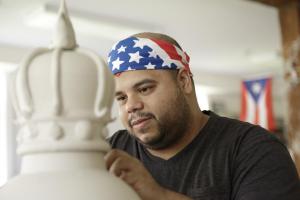 “The sort of questions that Marlboro students ask are aligned with the questions that I ask,” says Roberto Lugo, who joined Marlboro as the ceramics professor last fall. “People here just have a tendency to question everything, which is really refreshing. I would get bored just teaching people how to be technically virtuous potters. I’m more interested in how pottery relates to biology, how pottery relates to anthropology, and all these other ways that people here really question.”
“The sort of questions that Marlboro students ask are aligned with the questions that I ask,” says Roberto Lugo, who joined Marlboro as the ceramics professor last fall. “People here just have a tendency to question everything, which is really refreshing. I would get bored just teaching people how to be technically virtuous potters. I’m more interested in how pottery relates to biology, how pottery relates to anthropology, and all these other ways that people here really question.”
Rob didn’t always know he would be a ceramic artist. Growing up in West Philadelphia, he had a flair for painting graffiti art on abandoned buildings, but he recognized that the only way to be economically successful in that environment was selling drugs. When he realized that too many among his family and friends had suffered from violence or imprisonment due to their involvement in the drug trade, he left the city to live with a cousin in Florida. He started ceramics at a community college there, at the age of 25, and has never looked back. He received his bachelor’s in ceramics from Kansas City Art Institute and an MFA from Pennsylvania State University.
Marlboro is very different from the academic environments Rob had experienced in the past, not to mention the most rural environment in which he has found himself (he relished eating his first apple straight from a tree this fall, for example). What drew him to the college, as is the case for many faculty, was the close-knit community and students’ sense of engagement in their own self-designed course of study.
“I liked that Marlboro has a curriculum that sort of creates itself based on the interests of the students,” says Rob. “I knew if I wanted to walk on new terrain, and think about ways that clay hasn’t been used before, I would really have to be grounded by people who are doing similar things with their own interests. Since I got here I feel like I’m discovering something new every day.”
Rob sees ceramics classes as a unique environment for bringing people together as a community. His introductory class last fall included everyone from freshmen to local community members, including retired economics professor Jim Tober, and he liked creating an environment in which they could learn from each other. He’s found Marlboro to be unique, in his experience, in the level of openness and encouragement that students share with each other.
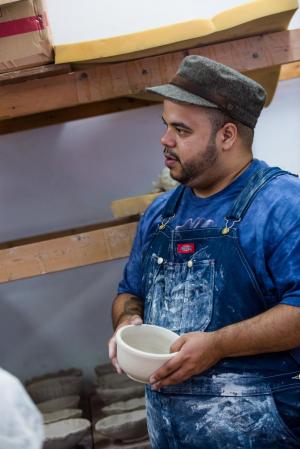 “With artwork, the conversation will be around communicating your idea rather than whether your idea is valid or not,” he says. “That’s what I like about it, because a person is welcome to express themself in whatever way they wish, and our jobs, as we critique the work, is to let that person know whether they are doing it effectively.”
“With artwork, the conversation will be around communicating your idea rather than whether your idea is valid or not,” he says. “That’s what I like about it, because a person is welcome to express themself in whatever way they wish, and our jobs, as we critique the work, is to let that person know whether they are doing it effectively.”
Rob’s own work juxtaposes images from popular culture, European decorative patterning, and rich symbolism drawn from his Puerto Rican heritage, creating a hybrid of visual arts traditions that stimulates new conversations surrounding cultural tolerance. His designs have ranged from combining graffiti and fine china to putting Nobel Prize laureate and Pakistani activist Malala Yousafzai and cartoon character Fat Albert on the same pot.
“It kind of gets people questioning what they hold dear about design,” says Rob. “Are you attached to the aristocratic component of it? Or are you willing to see where both of our needs, and both of our ideas, intersect? I like challenging people in that way.”
Rob believes that his physical work gains strength from his other work as an activist, doing public speaking and making videos that address poverty, prejudice, and injustice. In one video, he returned to Philadelphia, to a block of burned-out houses with “stairways going to nowhere,” where he assembled a pottery wheel out of discarded objects and threw a pot from clay reclaimed on site. His impassioned speech at the 2015 NCECA (National Council on Education for the Ceramic Arts) conference, where he was presented with an emerging artist award, has gained him national recognition.
“I think that sort of multimodal practice really lends itself to the Marlboro community,” Rob says. He is collaborating with economics professor John Rush on a project in Puerto Rico, where faculty and students will help introduce a sustainable pottery workshop to bring revenue to a disadvantaged community. He looks forward to collaborating with other professors as well, in areas of study from anthropology to performance art. One thing that remains to be seen is how Rob’s art will change from his experiences at Marlboro.
“My work has a close relationship with my experience as a human, and has always included a discussion of what it means to be a person of color from a really poor neighborhood,” says Rob. “Now I’m a professor, and I’m in Vermont, so what does that mean for my work? Am I going to draw a moose on my pots? Because I think that would actually look really cool.”
Nelli Sargsyan Pursues Empathy through Anthropology
Anthropology professor Nelli Sargsyan, who also joined the faculty in the fall, was drawn to Marlboro because of its close-knit and egalitarian community, in which she appreciates “the horizontality of structure.” She was impressed that there were engaged students on the search committee that interviewed her, and that people really know each other and make decisions together. Coming from a larger school, she also likes that Marlboro is still focusing on the liberal arts, not on vocational training.
“Marlboro allows space for exploring and thinking, which I really appreciate,” Nelli says. “The classes are small enough that you can engage in meaningful discussions with the students, and they have the freedom to go in directions that interest them.” She feels very aligned with the way writing and critical thinking are so crucial to Marlboro’s academic approach, and with the multidisciplinary nature of the learning environment.
“Here I am limited only by my imagination, in terms of the classes that I could teach, which is both overwhelming and really exciting,” she says. “It seems like Marlboro allows thinking across disciplines to happen very organically, among colleagues and also in response to students’ interests.” This semester she is teaching a course with photography professor John Willis that incorporates visual anthropology and social justice issues, and she looks forward to collaborating with other faculty across disciplines.
Originally from Armenia, Nelli received her bachelor’s degree from Yerevan State Institute of Foreign Languages, then her master’s and doctoral degrees in anthropology from State University of New York at Albany. She has taught in diverse college settings, from Yerevan State Linguistic University, in Armenia, to SUNY Albany, but she has never encountered the concentration of critically thinking students that she finds at Marlboro.
“It seems like the students who come to Marlboro are interested in posing the kinds of questions that I am interested in as well, re-examining certain social institutions or understandings of concepts and how these things operate in our lives. So that’s very exciting for me. I want students to be demanding of me, to make me do more intellectual work, question things, and push in directions that I haven’t explored, that we can engage in together.”
To Nelli, the goal of her classes at Marlboro is to help students think as anthropologists, with an awareness of our shared humanity and sensitivity to how lives and experiences are situated.
“Thinking like an anthropologist is being aware of this common humanity that we all have, of the fact that we share much more despite our differences. At the same time, it is being aware that these differences contribute to the flavor, the music, the color, and the texture of the human experience that one has. I think an anthropological way of knowing allows you to learn a lot about yourself, and about things that have informed your own way of living. This, then, makes it possible to listen more compassionately to many human stories, of which yours is just one.”
Nelli approaches teaching as an opportunity for cultivating social agency, the human capacity to make decisions and act on them, by engaging students in process-based and active learning experiences. One of the ways her students do this is by developing self-awareness and reflexivity, locating themselves in their own research.
“It’s about being aware that our own perspectives are always informed by the experiences that we’ve gone through, and are going through, that everything is tied to one’s own story. Creating an environment of empathy, in our little learning community of a classroom, gives the space where agency becomes possible outside the classroom as well.”
As far as her own research, Nelli’s doctoral work examined how Armenian-identified individuals negotiate their gender, ethnic, and sexual difference in the U.S. and in Armenia. Her dissertation resulted in a number of conference papers and publications, including a chapter in the book Creoles, Diasporas and Cosmopolitanisms: The Creolization of Nations, Cultural Migrations, Global Languages and Literature.
“I was interested in what it means to be Armenian for people who live in the U.S. diaspora, and how people navigate what it means to be Armenian of a certain gender, of a certain sexuality, of a certain race and religion. I was also interested in queer art-activism in Armenia, and as a result now I’m more interested in social movements in general.” Nelli looks forward to collaborating with Marlboro students on a field research project in this area.
Nelli considers Marlboro the perfect size, in terms of a functional community. When she visited the studio of ceramics professor Roberto Lugo, to make a bowl for the Empty Bowls Benefit Dinner, it occurred to her that her daughter’s elementary school class could help decorate some of the bowls. Rob said, “Yeah, sure.” Nelli talked to her daughter’s teacher, and, a week after Rob’s “Yeah, sure,” the primary class of Marlboro Elementary School was there in the studio, enriching the college campus with their energy and ensuring the bowl-making effort’s success.
“Just the ease with which things like that can happen is very significant to me,” says Nelli. “So besides the meaningful interdisciplinary collaborations, on a community level there’s this gentleness and connection that I appreciate.”
Also of Note
“I am fascinated by the algebraic structures on elliptic curves, especially elliptic curves defined over fields of finite characteristics,” says Ziyue “Zoey” Guo (pictured right), and there are few who could argue with her. Marlboro’s mathematics fellow for the academic year, Zoey completed her doctorate in mathematics in 2015, at Northwestern University, with a dissertation on Abelian graphs. “In particular, I look at the behavior in the Perron-Frobenius eigenvalues when a finite graph is expanded by adjoining two-valent trees.” She also enjoys playing the piano and viola, as well as rock climbing.
“I write short, weird fiction mostly, and I am planning a sci-fi novel but that is in a very preliminary stage,” says junior Derek Tollefson. He is also co-editor-in-chief of a remarkable literary journal called Milkfist, which came out with its debut issue in September 2015. Billed as “a compendium of art and writing for stammering low-lifes who barely know what year it is,” the magazine features work from both established and up-and-coming talents from all over the world.” Go to milkfist.com.
“I hold a special place in my heart for Arabic, as a poetic and beautiful language,” says Marwa Abayed, Marlboro’s Fulbright fellow in Arabic this year, who comes to us from Tunisia. “I believe it has been burdened with the most wrongful image as the language of ‘terrorists’ in the media.” Marwa has an undergraduate degree in English language, civilization, and literature, and has pursued graduate work in cultural studies and translations. She has been an active participant in the community, including performing in the recent production of The Language Archive.
“Kathy Urffer (pictured right) is the heartbeat of the grad school. Her title is registrar, but she is the driving force behind just about everything that happens here.” So says the entry nominating Kathy to win the first ever Staff Distinguished Service Award. The award is designed to honor Marlboro staff members for their contributions to the lives of one another and in service of the college’s mission. Among other things, Kathy was cited for organizing a group of staff to attend the Vermont Women in Higher Education conference last year.
Last year, senior Colin Leon joined his cousin Gray Davidson and a team of other sculptors to construct The Dancing Serpent, a 14-foot-long sculptural metal mobile inspired by some of the kinetic sculptures Colin included in his Plan show. The serpent-mobile was built to exhibit at Burning Man 2015, the annual festival of counterculture and pyrotechnics in Nevada’s Black Rock Desert, where it gained many admirers. “Gray received a small grant from Burning Man to complete the piece and was in charge of the aesthetic decisions and the organization of the project,” said Colin. “I was his engineer, consultant, and ‘chief’ welder.” See the sculpture.
“I have become accustomed to using a wide variety of language-learning resources, and to tailoring teaching strategies to suit individual learning styles,” says Ella Grunberger-Kirsh, this year’s Oxford Classics Fellow. Ella earned her master’s in classics from Exeter College with a dissertation on “Cultural politics and poetic voice in the work of Ausonius of Bordeaux,” which won Oxford’s top classics research prize. She has won several other awards and scholarships for her work, and is founder of the Oxford University Classics Society.
Mountain Mystery
New students Sam Bunker ’18 and Merritt Meehan ’18 investigated a mysterious clue during the Bridges orientation trip titled Haunted Treasure Hunt 2K15. Photo by Connor Lancaster ’16
Calling All Scholars
Marlboro gained national attention when National Public Radio’s Amy Scott did a story on the college’s Renaissance Scholars Program.
Circle Up
Students, faculty, and staff shared their ideas for Marlboro’s future during a “meet the trustees” event in November.
Gift Horse
Students made a casting of a horse’s head from the pediment of the Parthenon in a workshop taught by sculpture professor Tim Segar, using a mold made by sculptor William Tucker.
Gimme Shelter
Carpenters Don Caponcelli and Brent Johnson close in the roof of the new gazebo near the center of campus.
Events
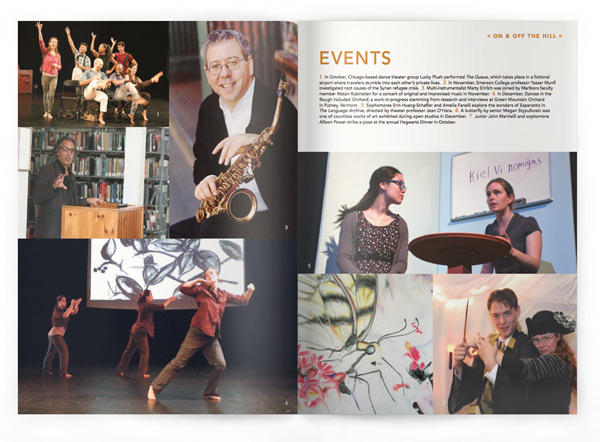
1 In October, Chicago-based dance theater group Lucky Plush performed The Queue, which takes place in a fictional airport where travelers stumble into each other’s private lives. 2 In November, Emerson College professor Yasser Munif investigated root causes of the Syrian refugee crisis. 3 Multi-instrumentalist Marty Ehrlich was joined by Marlboro faculty member Matan Rubinstien for a concert of original and improvised music in November. 4 In December, Dances in the Rough included Orchard, a work-in-progress stemming from research and interviews at Green Mountain Orchard in Putney, Vermont. 5 Sophomores Erin Huang-Schaffer and Amelia Fanelli explore the wonders of Esperanto in The Language Archive, directed by theater professor Jean O’Hara. 6 A butterfly by senior Megan Stypulkoski was one of countless works of art exhibited during open studios in December. 7 Junior John Marinelli and sophomore Allison Power strike a pose at the annual Hogwarts Dinner in October.
Focus on Faculty
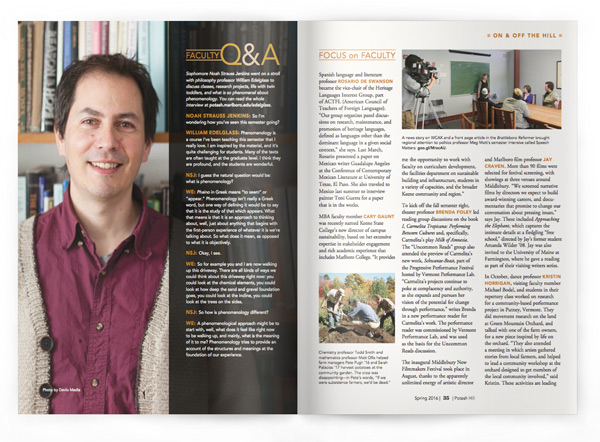
Faculty Q&A
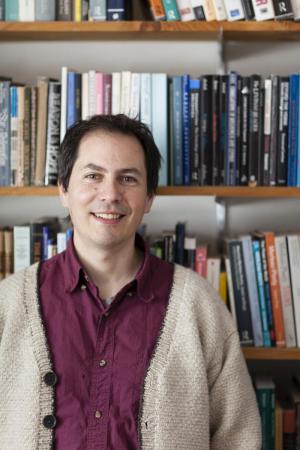 Sophomore Noah Strauss Jenkins went on a stroll with philosophy professor William Edelglass to discuss classes, research projects, life with twin toddlers, and what is so phenomenal about phenomenology. You can read the whole interview.
Sophomore Noah Strauss Jenkins went on a stroll with philosophy professor William Edelglass to discuss classes, research projects, life with twin toddlers, and what is so phenomenal about phenomenology. You can read the whole interview.
Noah Straus Jenkins: So I’m wondering how you’ve seen this semester going?
William Edelglass: Phenomenology is a course I’ve been teaching this semester that I really love. I am inspired by the material, and it’s quite challenging for students. Many of the texts are often taught at the graduate level. I think they are profound, and the students are wonderful.
NSJ: I guess the natural question would be: what is phenomenology?
WE: Phaino in Greek means “to seem” or “appear.” Phenomenology isn’t really a Greek word, but one way of defining it would be to say that it is the study of that which appears. What that means is that it is an approach to thinking about, well, just about anything that begins with the first-person experience of whatever it is we’re talking about. So what does it mean, as opposed to what it is objectively.
NSJ: Okay, I see.
WE: So for example you and I are now walking up this driveway. There are all kinds of ways we could think about this driveway right now: you could look at the chemical elements, you could look at how deep the sand and gravel foundation goes, you could look at the incline, you could look at the trees on the sides.
NSJ: So how is phenomenology different?
WE: A phenomenological approach might be to start with, well, what does it feel like right now to be walking up, and mainly, what is the meaning of it to me? Phenomenology tries to provide an account of the structures and meanings at the foundation of our experience.
Focus on Faculty
Spanish language and literature professor Rosario de Swanson became the vice-chair of the Heritage Languages Interest Group, part of ACTFL (American Council of Teachers of Foreign Languages). “Our group organizes panel discussions on research, maintenance, and promotion of heritage languages, defined as languages other than the dominant language in a given social context,” she says. Last March, Rosario presented a paper on Mexican writer Guadalupe Angeles at the Conference of Contemporary Mexican Literature at University of Texas, El Paso. She also traveled to Mexico last summer to interview painter Toni Guerra for a paper that is in the works.
MBA faculty member Cary Gaunt was recently named Keene State College’s new director of campus sustainability, based on her extensive expertise in stakeholder engagement and rich academic experience that includes Marlboro College. “It provides me the opportunity to work with faculty on curriculum development, the facilities department on sustainable building and infrastructure, students in a variety of capacities, and the broader Keene community and region.”
To kick off the fall semester right, theater professor Brenda Foley led reading group discussions on the book I, Carmelita Tropicana: Performing Between Cultures and, specifically, Carmelita’s play Milk of Amnesia. The “Uncommon Reads” group also attended the preview of Carmelita’s new work, Schwanze-Beast, part of the Progressive Performance Festival hosted by Vermont Performance Lab. “Carmelita’s projects continue to poke at complacency and authority, as she expands and pursues her vision of the potential for change through performance,” writes Brenda in a new performance reader for Carmelita’s work. The performance reader was commissioned by Vermont Performance Lab, and was used as the basis for the Uncommon Reads discussion.
The inaugural Middlebury New Filmmakers Festival took place in August, thanks to the apparently unlimited energy of artistic director and Marlboro film professor Jay Craven. More than 90 films were selected for festival screening, with showings at three venues around Middlebury. “We screened narrative films by directors we expect to build award-winning careers, and documentaries that promise to change our conversation about pressing issues,” says Jay. These included Approaching the Elephant, which captures the intimate details at a fledgling “free school,” directed by Jay’s former student Amanda Wilder ’08. Jay was also invited to the University of Maine at Farmington, where he gave a reading as part of their visiting writers series.
In October, dance professor Kristin Horrigan, visiting faculty member Michael Bodel, and students in their repertory class worked on research for a community-based performance project in Putney, Vermont. They did movement research on the land at Green Mountain Orchard, and talked with one of the farm owners, for a new piece inspired by life on the orchard. “They also attended a meeting in which artists gathered stories from local farmers, and helped to lead a community workshop at the orchard designed to get members of the local community involved,” said Kristin. These activities are leading up to an Orchard Pageant planned for July 2017 that will include dancing, puppets, and music.
In December, politics and gender studies professor Meg Mott participated in a CNN roundtable titled “Why Do Politicians Get Away with Lying?” “In America, when it comes to populist interests, facts are not as legitimate as feelings,” writes Meg. “At least when it comes to running election campaigns.” In August, Meg was quoted in a Christian Science Monitor article, also picked up by Yahoo.com, titled “Why Is ‘Teflon Trump’ Still So Popular?” Learn more. Meg was also quoted in a QC Research article titled “Young Voters,” where she applauded the key role young voters are playing in reframing political debate from one on “law and order” to one about justice and legitimacy.
In January 2015, economics professor John Rush presented a paper at the Economics of Global Poverty conference in Wenham, Massachusetts, titled “The Impact of Natural Disasters on Poverty in Indonesia.” He was also invited to present at the Southern Economic Association’s annual meeting in New Orleans in November, where he spoke about “Rural Households, Education, and the Empact of El Salvador’s 2001 Earthquakes.” “Both papers flow from my research agenda exploring the fact that natural disasters affect families not just through direct impacts but also by disrupting the businesses, institutions, and infrastructure of the wider community,” says John.
In October, Library Director Beth Ruane presented a “faculty forum” on her ongoing research in Nepal, titled “Searching in Nepal: Information-Seeking Behavior in Kathmandu.” “Libraries have always been a place of change and adaptation, and important places within a community where resources and ideas can be freely shared,” says Beth. “Without the information infrastructure upon which we have come to depend, how does knowledge circulate in Nepal?” In November and December, Beth traveled to Kathmandu to further her research on this and related questions.
As the co-curator of the New Metrics channel of Sustainable Brands, MBA faculty member Bill Baue helped organize the New Metrics Conference in Boston last October. “This year’s agenda, in my humble opinion, is the best so far in the history of the conference,” says Bill, who facilitated workshops on “Net Positive” and “Materiality,” in addition to speaking in sessions on “ThriveAbility.” MBA faculty member Mark McElroy also facilitating a workshop on the MultiCapital Scorecard. Bill and Mark co-authored an article in the July 2015 Journal of Responsible Finance, as well as parts of a new book titled A Leader’s Guide to ThriveAbility: A Multi-Capital Operating System for a Regenerative, Inclusive Economy. Mark also coauthored an article on the MultiCapital Scorecard in Harvard Business Review.
In October and November, psychology professor Tom Toleno discussed “Exploring Modern Africa” in a series of lectures, part of the fall lecture series at the Osher Lifelong Learning Institute, in Dummerston, Vermont. Subjects included postcolonial African society, religion, literature, culture, and education, as well as issues around working in Africa. Tom shared his experiences living, traveling, and working extensively in Africa, particularly in the Republic of Malawi.
MBA faculty member Lori Hanau had an article titled “The Paradigm Shift to Shared Leadership: From Round Earth to Flat Hierarchies” in the fall issue of Conscious Company magazine. “Of course, the earth was always round, even when we believed it wasn’t,” writes Lori. “When we change our paradigms, we make visible what we couldn’t imagine before.” In October, Lori also spoke at a Conscious Company “Sum+Substance” event, where she participated in a panel on the path to fulfilling work. Learn more.
In November, faculty members Cathy Osman (painting), John Willis (photography), and Seth Harter (Asian studies) participated in the first annual symposium of the Six Colleges Collaborative, a partnership of colleges in southeastern Vermont. The symposium, titled “Linking Your Course to the Community and Beyond,” explored ways to connect students to local employers, agencies, and civic organizations. In two roundtable discussions, the Marlboro faculty members shared their experiences enhancing student learning through interaction with community partners.
In November, religion professor Amer Latif gave a talk titled “The Sighs of Abraham: A Qur’anic and Sufi Portrait” at the All Souls Church in West Brattleboro. “The Qur’an describes Abraham as clement, and sighing often,” says Amer, who reflected on some of the ways in which Muslim contemplatives have understood Abraham’s friendship with God and his qualities of clemency and patience. Amer also led a discussion on campus about spiritual health, part of Student Life’s holistic education program titled For Your Engagement (FYE). In the words of one admiring sophomore who attended, “Amer totally killed it.”
In the last year, philosophy professor William Edelglass completed his term as co-director of the International Association of Environmental Philosophy, but he has remained busy regardless. He taught a graduate seminar on Phenomenology of the Body at the Indian Institute of Technology–Bombay, one of the top universities in India. William was interviewed by Insight Journal for an article titled “Cultivating Bodhicitta: Wisdom and Compassion in Śāntideva’s Introduction to the Awakened Life” (April 2015), and he has two chapters forthcoming in philosophy books to be published this year. William has also given several invited lectures in the past year, including “Describing the Beyond of Language: Phenomenology and Apophatic Discourse,” at the October meeting of the Society for Asian and Comparative Philosophy, in Atlanta.
In her new role as director of Marlboro’s Center for Creative Solutions, art history professor Felicity Ratté is currently in the throes of organizing a Spring Convening in April, on the subject of the future of public education. “Many of us in Windham County are thinking about Act 46 right now,” says Felicity. “The aim of this workshop is to think beyond the act. This event is structured to create a space where stakeholders can begin to define the “equity,” “excellence,” and “value” that the act promotes.
As a member of the Women’s Resource Center Advisory Board, physics professor Sara Salimbeni helped organize a reading and discussion of the book Schoolgirls, by Peggy Orenstein, at the beginning of the spring semester. The book explores the struggle with self-esteem some girls experience during adolescence, and the social costs of gender stereotypes in terms of declining academic achievement, especially in math and science.
Photography professor John Willis and music professor Matan Rubinstein collaborated to create a multimedia piece, part of the Eyes on the Land show at Shelburne Museum’s Pizzagalli Center for Art and Education last fall. The result of a partnership between the Shelburne Museum and Vermont Land Trust, the exhibit commissioned 13 contemporary Vermont artists and photographers to produce new works using conserved lands as their inspiration. John and Matan contrasted images and sounds from the Bunker Farm, in Dummerston, Vermont, with images and sounds from a scrap-metal yard, in their composition called “Inhabitation, Production/Consumption.” Learn more.
2015 Graduate Commencement
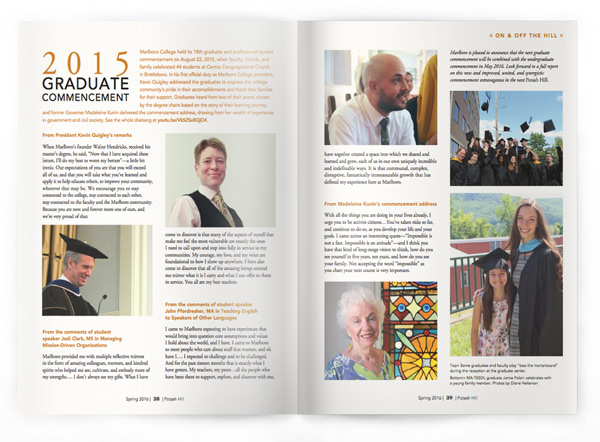
Marlboro College held its 18th graduate and professional studies commencement on August 22, 2015, when faculty, friends, and family celebrated 44 students at Centre Congregational Church, in Brattleboro. In his first official duty as Marlboro College president, Kevin Quigley addressed the graduates to express the college community’s pride in their accomplishments and thank their families for their support. Graduates heard from two of their peers, chosen by the degree chairs based on the story of their learning journey, and former Governer Madeleine Kunin delivered the commencement address, drawing from her wealth of experience in government and civil society. See the whole shebang.
From President Kevin Quigley’s remarks
When Marlboro’s founder Walter Hendricks, received his master’s degree, he said, “Now that I have acquired these letters, I’ll do my best to worst my betters”—a little bit ironic. Our expectations of you are that you will exceed all of us, and that you will take what you’ve learned and apply it to help educate others, to improve your community, wherever that may be. We encourage you to stay connected to the college, stay connected to each other, stay connected to the faculty and the Marlboro community. Because you are now and forever more one of ours, and we’re very proud of that.
From the comments of student speaker Jodi Clark, MS in Managing Mission-Driven Organizations
Marlboro provided me with multiple reflective mirrors in the form of amazing colleagues, mentors, and kindred spirits who helped me see, cultivate, and embody more of my strengths…. I don’t always see my gifts. What I have come to discover is that many of the aspects of myself that make me feel the most vulnerable are exactly the ones I need to call upon and step into fully in service to my communities. My courage, my love, and my voice are foundational to how I show up anywhere. I have also come to discover that all of the amazing beings around me mirror what it is I carry and what I can offer to them in service. You all are my best teachers.
From the comments of student speaker John Pfordresher, MA in Teaching English to Speakers of Other Languages
I came to Marlboro expecting to have experiences that would bring into question core assumptions and values I hold about the world, and I have. I came to Marlboro to meet people who care about stuff that matters, and oh have I…. I expected to challenge and to be challenged. And for the past sixteen months that is exactly what I have gotten. My teachers, my peers…all the people who have been there to support, explore, and discover with me, have together created a space into which we shared and learned and grew, each of us in our own uniquely incredible and indefinable ways. It is that communal, complex, disruptive, fantastically immeasurable growth that has defined my experience here at Marlboro.
From Madeleine Kunin’s commencement address
With all the things you are doing in your lives already, I urge you to be activist citizens…You’ve taken risks so far, and continue to do so, as you develop your life and your goals. I came across an interesting quote—“Impossible is not a fact. Impossible is an attitude”—and I think you have that kind of long-range vision to think, how do you see yourself in five years, ten years, and how do you see your family. Not accepting the word “impossible” as you chart your next course is very important.
Marlboro is pleased to announce that the next graduate commencement will be combined with the undergraduate commencement in May 2016. Look forward to a full report on this new and improved, united, and synergistic commencement extravaganza in the next Potash Hill.
Alumni News
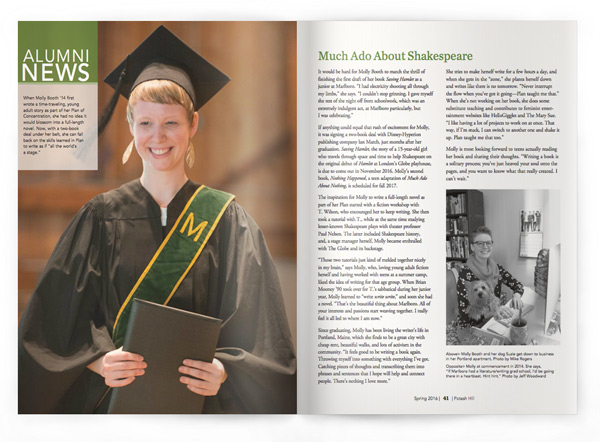
Much Ado About Shakespeare
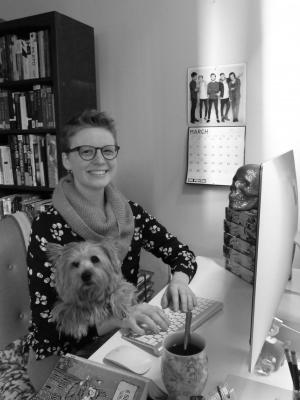 When Molly Booth ’14 first wrote a time-traveling, young adult story as part of her Plan of Concentration, she had no idea it would blossom into a full-length novel. Now, with a two-book deal under her belt, she can fall back on the skills learned in Plan to write as if “all the world’s a stage.”
When Molly Booth ’14 first wrote a time-traveling, young adult story as part of her Plan of Concentration, she had no idea it would blossom into a full-length novel. Now, with a two-book deal under her belt, she can fall back on the skills learned in Plan to write as if “all the world’s a stage.”
It would be hard for Molly Booth to match the thrill of finishing the first draft of her book Saving Hamlet as a junior at Marlboro. “I had electricity shooting all through my limbs,” she says. “I couldn’t stop grinning. I gave myself the rest of the night off from schoolwork, which was an extremely indulgent act, at Marlboro particularly, but I was celebrating.”
If anything could equal that rush of excitement for Molly, it was signing a two-book deal with Disney-Hyperion publishing company last March, just months after her graduation. Saving Hamlet, the story of a 15-year-old girl who travels through space and time to help Shakespeare on the original debut of Hamlet at London’s Globe playhouse, is due to come out in November 2016. Molly’s second book, Nothing Happened, a teen adaptation of Much Ado About Nothing, is scheduled for fall 2017.
The inspiration for Molly to write a full-length novel as part of her Plan started with a fiction workshop with T. Wilson, who encouraged her to keep writing. She then took a tutorial with T., while at the same time studying lesser-known Shakespeare plays with theater professor Paul Nelsen. The latter included Shakespeare history, and, a stage manager herself, Molly became enthralled with The Globe and its backstage.
“Those two tutorials just kind of melded together nicely in my brain,” says Molly, who, loving young adult fiction herself and having worked with teens at a summer camp, liked the idea of writing for that age group. When Brian Mooney ’90 took over for T.’s sabbatical during her junior year, Molly learned to “write write write,” and soon she had a novel. “That’s the beautiful thing about Marlboro. All of your interests and passions start weaving together. I really feel it all led to where I am now.”
Since graduating, Molly has been living the writer’s life in Portland, Maine, which she finds to be a great city with cheap rent, beautiful walks, and lots of activism in the community. “It feels good to be writing a book again. Throwing myself into something with everything I’ve got. Catching pieces of thoughts and transcribing them into phrases and sentences that I hope will help and connect people. There’s nothing I love more.”
She tries to make herself write for a few hours a day, and when she gets in the “zone,” she plants herself down and writes like there is no tomorrow. “Never interrupt the flow when you’ve got it going—Plan taught me that.” When she’s not working on her book, she does some substitute teaching and contributes to feminist entertainment websites like HelloGiggles and The Mary Sue. “I like having a lot of projects to work on at once. That way, if I’m stuck, I can switch to another one and shake it up. Plan taught me that too.”
Molly is most looking forward to teens actually reading her book and sharing their thoughts. “Writing a book is a solitary process; you’ve just heaved your soul onto the pages, and you want to know what that really created. I can’t wait.”
Check out what Molly and two other recent alumni had to say about transitioning to the world beyond Potash Hill, during last October's Open House and Family Day events. Also, see what's come from alumni writers in the past year in Book Shelf.
Class notes are listed by year and include both graduates and nongraduates; the latter are listed under the class with which they are associated.
’51
“Our year was richly enhanced with two different and memorable trips abroad—both European river cruises,” writes CHARLES STAPLES. “The first was a Danube cruise from Passau to Budapest, preceded by a two-day visit to Prague, and the second was in France, a ten-day trip on the Seine River. We continue to be very involved in our Chicago community of Hyde Park and the First Unitarian Church. Joan is still singing, and I still volunteer at the Chicago Cultural Center. We are ‘museum junkies,’ admiring many genres.”
’52
ELMER and GERTRUDE PINION GREEY write, “This year we celebrated 63 years of marriage, and our 87th birthdays. We’re both still active in church. Elmer volunteers at U.S. National Arboretum, and with master gardeners. Gertrude occasionally helps church music—an organist for 25 years. We have five living children, 23 grandchildren, and six great grandchildren.”
’55
The first Marlboro student to graduate with a concentration in painting, artist LINN BRUCE was featured in an exhibit at the Brattleboro Museum & Art Center in November and December. The show, Stories in Color: Linn Bruce, offered a sampling of work spanning six decades. According to Nora Williams, curator, Bruce’s paintings “exploit the ability of color to evoke emotional and symbolic associations, as well as to describe the world.”
’63 “Still teaching at University College at Rockland (U-Rock),” writes Jonathan Potter. “Currently my course is a history of theatre. Next semester will be an acting class. Just had some poetry published in the Goose River Anthology.”
’66
WESLEY WARD writes, “The new president has made a great start, and the Northern Borders premium is much appreciated. Keep on trucking, Marlboro.”
’67
“Early winter with snow—so nice to see after a horrendous fire season,” writes JENNIE TUCKER. “All is well here in the Blue Mountains of northeastern Oregon.”
SPOTT RANDOLPH reports that he is now a consultant working with car collectors. He writes, “Moved to Florida in 2008, where I ran the office for a propellor shop.”
’68
“Best wishes to all on the hill,” writes WILLIAM "GUY" CAIN. “I hope to get back to campus sometime in 2016, and would love to meet Kevin.”
“I am still actively engaged in theater and therapy,” writes DINAH LANE. “Working with a small, town-funded family therapy team in Burlington, Massachusetts, and recently appointed artistic director of the Latham Players, a performance group of adults on Cape Cod with Prader-Willi syndrome. Enjoying it all.”
’69
JOHN DEVANEY exhibited his artwork at Robert Foster Fine Art, on Nantucket, in August. He talks about discovering theater in college in a profile in Yesterday’s Island/Today’s Nantucket, reprinted from a 2003 article. “A up touring for about eight years, and also had its own theater in Brattleboro. That was a social focus for me, too, because my friends in college were the ones I ended up working with, virtually 24 hours a day.” See the profile. John will have a solo show in Midtown Manhattan, at Gallery 35NYC, in April, with a reception on April 9 from 6 to 8 pm. See some of his work at johndevaney.com.
WENDY NUTE ISHII writes, “It was such a wonderful treat to meet President Kevin Quigley, Alumni Director Kathy Waters, and several new faculty members, and to see old friends from my Marlboro years on my recent visit in October—all capped by a delightful stay at the Whetstone Inn cradled in Jean Boardman’s warmth and hospitality and a sinfully delectable breakfast.”
’71
CHRISTINE HUDSON ABRAMS writes, “Still live on Martha’s Vineyard; see SOO WHITING ’67 at the post office, JENNIE GREEN ’68 around town, and other Marlboro folk.”
’72
“We were surprised to hear the special on Marlboro College on NPR,” writes HAROLD ZAKON. “Keep up the good work, and good luck with your new plan for admissions. I would be happy to visit with any potential applicants from Austin.”
’76
KATHLEEN SMITH reports that she is “fulltime faculty at Rhode Island College, School of Nursing, in Providence.”
’78
SARAH EDWARDS is now living in Ohio and is the executive director for Simply Living (simplyliving.org), an organization that works to create a compassionate and sustainable world through personal, community, and cultural transformation. She writes, “I will always be grateful for my education from Marlboro. It was the only college I applied to. I was rejected, because I could hardly compose a sentence. Confused, I telephoned and said, ‘But I thought you were in the business of teaching people how to write. I need and want to learn how to write.’ The rejection turned into an acceptance, and writing is a big part of what I do in the world.”
NATHANIEL SIMKINS writes, “Began showing new paintings at gallery in New Bedford this year and plan on becoming a member in 2016. New work is based on life painting around Wareham and Onset.”
’80 ROSE CROWLEY CHRISTIAN writes, “Love the Renaissance Scholars concept. Good luck, Quigley.”
CARY BARNEY is currently director of the fine and performing arts department at Saint Louis University’s campus in Madrid. “I teach dramatic literature, acting, creative writing, and sometimes playwriting. I also direct a play each semester, most recently one of my own, Lance & Lana, a modern take on Georg Büchner’s Leonce and Lena. Doing theater on a shoestring at Marlboro was good training for this. My son Sam is in his first year studying history at the Universit. de Toulouse. In the past couple of years I’ve enjoyed visits from INEZ McDERMOTT ’79 and DIANE GAGER ’82. I’d love to hear from anyone passing through Madrid.”
’81
“I’m a psychotherapist in private practice in the Midwest,” writes JOANNA HOCHFELDER. “Attended Tulane University after Marlboro College. Marlboro is a unique place of learning that will always be close to my heart.”
’82
REBECCA JERVIS LEEMAN writes, “Besides leading a team of seven midwives, including doing clinical practice of midwifery and women’s health, I started singing in a group in Albuquerque, a global choir— secular folk. True to the Vermonter in me, I introduced some shape-note tunes into our repertoire. Singing in Arabic, Bulgarian, and other throat-opening dialects keeps life interesting. Shout-out to Marlboro friends.”
’83
XENIA WILLIAMS writes, “The most recent big Renaissance project in Vermont was a scheme by the big Burlington medical complex—then called Fletcher Allen Health Care—for new buildings and a parking garage with illegal aspects in its funding. Big scandal—the FAHC president went to jail.”
’86
“ANDERS NEWCOMER received his MAT in January 2015, from UMass Dartmouth,” writes his mom, Grace. “He teaches English at Greater New Bedford Vocational Technical High School.”
Conserving Wetland Values: Rebecca Chalmers ’98
“Approximately 20 years ago I found and recorded vernal pools around Marlboro,” says Rebecca Chalmers, who graduated in 1998 with a Plan of Concentration on amphibian ecology and conservation. “Now I am tasked with protecting those very pools.”
As a district wetland ecologist for the Vermont Agency of Natural Resources, Rebecca helps identify and protect approximately 100,000 acres of wetlands and buffer zones in southern Vermont. Along with delineating wetland boundaries and identifying hydrophytic (water-loving) plants, hydric soils, and hydrology, Rebecca assesses the important wetland “functions and values” identified by the state—things like wildlife habitat, erosion control, and surface and ground water protection.
“I love the quiet in a wetland infrequently traversed by people. The plants seem so vibrant, in song somehow, when I’m in a diverse, healthy community,” says Rebecca. “This year I discovered new populations of a federally endangered plant and a rare salamander, both in the same wetland. I get to be outside in beautiful places, and I learn from everyone I meet.”
Rebecca is often required to negotiate with permit applicants to come up with alternate plans that have less environmental impact to wetlands. Permits may be for something as simple as a deck, as large as a cross-state power supply line, or as complex as a mountainside resort that affects dozens of wetlands in multiple ways.
When she is not traipsing through tamarack–red maple swamps, Rebecca enjoys camping, canoeing, bicycling, and exploring outside with her family. “Advocacy for the hearing disabled is a newfound passion,” says Rebecca. “I plan to use my regulatory experience to help others.”
’90
“We like to call ourselves an incubator,” says SARA COFFEY, founder and director of Vermont Performance Lab, in an interview on Vermont Public Radio. “We are an incubator for new work in contemporary dance, theater, and music.” Learn more.
“My first novel was published by Green Writers Press of Brattleboro this fall,” writes BRETT ANN STANCIU (see Book Shelf). “I was at my niece’s graduation in May 2014, and it was such a pleasure to see Marlboro looking so fine. Furthermore, Andrew Delbanco’s speech reminded me all over again just why I am so fortunate to have attended this great college.”
’91 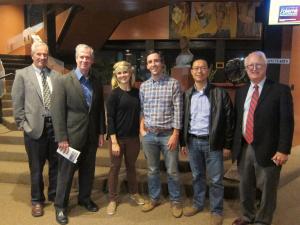 “Life is beautiful,” writes JUNO LAMB. “Potash Hill is a lovely, well-designed magazine, a pleasure to read. So sweet to see old Marlboro friends at the JALF evening—a joy.”
“Life is beautiful,” writes JUNO LAMB. “Potash Hill is a lovely, well-designed magazine, a pleasure to read. So sweet to see old Marlboro friends at the JALF evening—a joy.”
“I have done a good bit of work treating Tibetan refugees for hepatitis B, which is a fairly serious epidemic in Tibet,” writes ANNA ABELE, a naturopathic doctor practicing in West Brattleboro. She has quite a few friends in the Tibetan community in Western Massachusetts, where she lives, and she was sought out by a monk from the Chungpo region because she had treated a nun from his monastery. “My long-term goal would be to go over there and/or have some monks or nuns come here to apprentice with the herb farm where many of these herbs are grown.”
’92
“I recently published a book with Cambridge University Press, entitled Foreign Opera at the London Playhouses, from Mozart to Bellini,” writes CHRISTINA FUHRMANN (see Book Shelf). “This is the culmination of my love for research, which all began with my Plan at Marlboro.” Learn more.
JENNIFER CHANDLER-WARD is founder and director of the Multicultural Teaching Institute, a conference that looks at the intersection of teaching and identity. Jenna leads workshops on issues of race, privilege, and unconscious bias in schools and institutions around New England. Learn more.
’94
BECKY WATSON MOKOS writes, “What a great reunion. So nice to see everyone, and thanks to all who made it happen.”
’95
“It feels good to be in touch,” writes MARYA PLOTKIN. “I do keep in touch with some alumni, like RACHEL PORTESI AHO ’98, AMY HEARD ’96, CORIN CUMMINGS. I have moved back to the US as of about one year ago, after living in Tanzania for the last six years. I work in public health research. I had actually just written requesting a transcript, because I am applying to a doctoral program here in North Carolina.”
KRISTIN ANDERSON’s organization MANOS continues to help bring nursing expertise to women and children in Nicaragua, most recently teaching a course in “essential care for every baby” at the Mesoamerican Pediatric Congress in Managua. See their new website, designed by Kristin.
’96
JANAN COMPITELLO GUILLAUME writes, “Mendel and I had our first child—Mendel Isaac—on October 20, 2014.”
’97 “I’m still loving my job at The Commons newspaper in Brattleboro,” writes WENDY LEVY. “Who knew it was the perfect job for me? I’ve had the opportunity to interview all sorts of interesting people, including Jerry Levy, when he debuted his play, The Third Coming: Marx Returns. It was a treat to go back to Jerry’s house after so many years and chat with him. The ethos of Marlboro helped me feel comfortable talking to pretty much anyone, from a neighborhood shopkeeper to a member of congress.”
JENN KARSTAD writes, “For over the past year I have been working hard at the Anna Marsh Behavioral Care Clinic, the outpatient mental health program of the Brattleboro Retreat, as a program therapist. Psychotherapy is an amazingly rewarding field, and I work with some of the most dedicated professionals I have ever known. JODI CLARK ’95 and I bought the house of DARRELL WILLIAMS ’92 in the summer of 2014, and it is just about the most perfect place for us. Stop by anytime.”
’98
In November, NORA DANIEL exhibited her work at Art@ 43023, a cooperative gallery in Granville, Ohio. “Her work, which has won awards from the Ohio Arts Council and was exhibited in the Governor’s mansion, has a unique compositional and coloristic style,” said publicity for the show.
’02
“I’m thrilled to report that Seth and I welcomed our second daughter, Prudence Kathleen, in May 2015,” writes SHANA DUNCAN. “Prudence is quite possibly the world’s most delightful baby, and Edie has excitedly embraced her role as big sister. In addition to becoming a big sister, Edie is now a kindergartener at the Chinese American International School, here in San Francisco. We’re feeling very proud—and wondering where all the time has gone.”
MELANIE GOTTLIEB writes, “I just left my institutional role to accept the deputy director position at AACRAO (American Association of Collegiate Registrars and Admissions Officials) in August. I direct marketing and communications for the association, and lead the international education and services division.”
’03 “We were inspired to give to Marlboro again after reading about the Renaissance Scholars program,” write LARA KNUDSEN and CHRISTOPHER JONES ’05. “It seems to redirect focus to the relationship between students and faculty, which was the aspect of Marlboro we both loved best (a teacher, a book, and a log...).”
“I am still living in Providence, Rhode Island, and in my fifth year of teaching movement in the Brown/Trinity MFA programs for acting and directing,” writes SHURA BARYSHNIKOV. “I’ve had a busy performance year, appearing this past fall in Oscar Wilde’s Salomé in Boston with Bridge Repertory Theater of Boston and co-founding Doppelganger Dance Collective, a duets dance project focused on the creation and performance of new choreographic works. I am incredibly busy, working both the creative and administrative side of things, but I wouldn’t have it any other way. My daughters are also thriving and will soon both be towering over me. Learn more at shurabaryshnikov.com and doppelgangerdancecollective.com.
’04
ABBY CASE FITZGERALD is the founder and principal of Yellow Arrows, LLC, an innovative consulting services company dedicated to working with higher education administrators in the areas of admissions and marketing, data and operations, and strategy and innovation. Prior to starting Yellow Arrows, Abby spent almost a decade working in admissions at Northeastern University School of Law in Boston, Massachusetts.
’05
“I see this as an award for Calcutta Kids and the outstanding work that our team does day in and day out in the slum community in which we work,” said NOAH LEVINSON, who was one of the recipients of the Caring Award in October. Noah founded Calcutta Kids in 2002, as part of his internship for the World Studies Program, and since then has been providing health and nutrition services to pregnant women, mothers, and their children in underserved slums in and around Kolkata, India. Read more.
“I have found my calling, after starting as a Marlboro student interested in philosophy, religion, and psychology,” writes CHRISTOPHER GRENIER. “Now I am a chaplain at a state psychiatric hospital. Some ministers say that they see Jesus in the faces of their parishioners, but I meet Jesus every day in the persons of my patients, especially those who say, ‘Hello, I am Jesus!’”
’06
“Rob and I had our first child, Arthur, almost a year ago now,” writes SARAH WAGGONER ZIMMERMAN. “I am also excited to announce that—in addition to my respectable day job of nurse practitioner— I have started moonlighting as the poetry editor for Friends Journal, a monthly magazine of Quaker life and thought. Only Marlboro could turn out a biology major prepared to take on poetry and theology. I’m so grateful.”
“As of this past August, I’m finally back in school,” writes JOCELYN DELMAN MOSSER. “I’m enrolled at Appalachian State University, and very excited to be pursuing licensure in the state of North Carolina to practice counseling. Meanwhile, I’m still making art with my sister, teaching yoga, and working as a marketing consultant and graphic designer on the side. Greg and I bought a sweet little farm outside Asheville, North Carolina, where we continue to adore one another.” Learn more at JosieMosserYoga.com, AbacusCorvus.com, and CrowboatCreative.com.
’08
“Some days we’re setting up and we hear eagles calling to each other, and we run out and look up,” says KIT HARRINGTON in a recent New York Times article. “Kids are the best at sharing in joy and wonder.” The article features the “preschool without walls” she founded in Seattle, called Fiddleheads Forest School, now in its third year. Find out more.
CARA DOWNEY has been an employee at Memorial Sloan Kettering Cancer Center since 2009, working in a Phase I Clinical Trials Chemotherapy Unit. She writes, “I am enrolled in a mental health counseling program at Pace University and currently completing my clinical internship at New York Presbyterian Payne Whitney Clinic. I also developed and facilitated an intergenerational group at the White Plains LGBT Center. The group focused on bringing together people of different ages with the goal of community building.”
Sharing the Human Experience of War: Brandon Willitts ’12
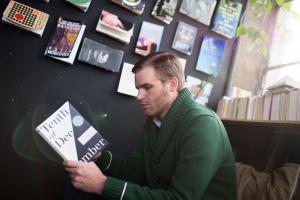 The year after he graduated from Marlboro with a Plan in literature and writing, Brandon Willits founded Words After War, a literary organization with a mission to bring veterans and civilians together to examine war and conflict. He had come to Marlboro after four years in the military, and believed that a deeper empathy between civilians and veterans was necessary and possible through literature.
The year after he graduated from Marlboro with a Plan in literature and writing, Brandon Willits founded Words After War, a literary organization with a mission to bring veterans and civilians together to examine war and conflict. He had come to Marlboro after four years in the military, and believed that a deeper empathy between civilians and veterans was necessary and possible through literature.
“From its inception, Words After War has aimed to build an inclusive community that uses literature as a way for civilians and veterans to better discuss war,” says Brandon, who founded the organization with fellow writers Mike McGrath and Matt Gallagher. “I chose writing and books because I knew how instrumental each had been in guiding me toward a fuller understanding of my own experiences with war.”
In two short years, Words After War has hosted more than 40 events with well-known and emerging writers, five semester-long writing workshops, literary mentorships, and monthly book clubs. It’s also held two weeklong, summer writing intensives at Marlboro College, where veterans and civilians participated in workshops and readings with published authors and Marlboro writing professor John Sheehy.
“The opportunity to bring Words After War to Marlboro has felt like my gift back to college for all that it provided me,” says Brandon, who is also vice president and head of internal communications at First Data, a leading payment processor. “Marlboro changed my life, and I want to show others just how special it is.” Learn more at wordsafterwar.org.
’10
“I am currently in my final year at the School of the Art Institute of Chicago, working toward my master’s in art education, writes ARIELLA MILLER. “I am also a curatorial fellow at SAIC, and will be one of 12 other graduate students curating the 2016 MFA show. In fact, I’m on a team with IAN (GABE) WILSON ’11. It’s a big small world out there. In personal news, I’m recently engaged to my partner of five years, and we’ve set a date. We live together in Chicago with our cat, Ludi.”
"MICHAEL THOMPSON is alive and well, playing guitar in the rock band Silverface in Denver, Colorado,” write his parents, Stephen and Ingrid.
WILLSON GAUL is working as a research assistant in an environmental science graduate program in Wisconsin. He writes, “I am developing plant- and animal-based ecological indicators to evaluate and monitor the health of ecosystems in the Great Lakes. Catching the eye of environmental science graduate professors was difficult, given my writing undergraduate degree. But once I got into the program, I’ve been able to quickly take on exciting parts of large projects because I am able to solve problems and teach myself as needed.”
’11
KARIM LAHLOU is working at Huffington Post, as editor of Men’s Lifestyle. “I work on the branded content team, helping to monetize an international subscription-free news website, which includes in-depth reporting, writing longform articles, and pitching creative story ideas to clients. I’ve often been asked if I would choose a different college if I could go back in time, and the answer has always been a resounding no. I enjoyed every year I spent there, and I owe a great deal of my professional success to the time I spent at Marlboro.”
’12 DREW TANABE is in his first year studying environmental policy at Cambridge University. “It’s the first time I’ve ever attended lectures, which are exciting, boring, and confusing. It is also the first time I’ve had 100 percent of a course grade depend on a single paper at the end, which is incredibly stressful. England is a great place to be, even if it’s a bit dreary and the sun sets early. There’s plenty going on around the university, and it feels criminal to spend an hour doing nothing. If anyone’s in the ‘Old Blighty’ in the spring or summer please let me know.”
BRANDON WILLITTS spoke about returning from war and reentering society at a symposium last October at Wesleyan University, cosponsored by his literary organization Words After War. The daylong symposium, the first of its kind, featured veterans who had served in Iraq, Afghanistan, Egypt, Yugoslavia, and Kosovo, alongside teachers and others from the writing industry who have focused their careers on writing about war and conflict. These discussions are important, he said, because “war is the human experience, the human story.”
CASEY FRIEDMAN is living his dream of working on a randomized trial of development projects through Innovations for Poverty Action. “Our trial is in rural Western Kenya, a few miles from the Obama family homestead (really), and we have 960 local farm households in the study,” writes Casey. “The researchers are trying to determine what keeps smallholder farmers from figuring out which products are most profitable to use on their farms. Managing and monitoring everything that has to happen on a mercurial but unforgiving agricultural calendar is pretty challenging, but I have an enormously talented local field manager who has been on the trial circuit for five years to take care of most of the details.”
’13
In August, MADDIE HOLM joined Child Hunger Corps, Feeding America’s nationwide service program designed to alleviate child hunger. Maddie is a fulltime corps member at Good Shepherd Food Bank of Maine for a two-year assignment, during which she will assess and develop the organization’s capacity and learn about food banks’ vital role in fighting child hunger.
’14
“I’m currently a master’s candidate serving as a volunteer with the first Peace Corps cohort in Comoros in 20 years,” writes NICK DAOU. “I’m working on my PACT degree from SIT, writing a capstone on the inter-island reconciliation process in the Comorian archipelago.”
“I have a level of faith in human reason and the power of communication that often verges on naIve. It is a stubborn faith, but not immune to being shaken. And, lately, it has been severely shaken,” writes AMEE LATOUR, in a January article in CounterPunch titled “When Facts Fail: Can We Change Hearts and Minds?” Amée currently works as a freelance writer and plans to attend graduate school for further work in philosophy. Read more.
’15 Since graduating, NINA RODWIN has been working at the Paul Revere House, in Boston, where she also had an internship the summer before her senior year. “I ended up writing a paper about the history of the subway in Boston that not only became the independent section of my Plan, but also was published in the Paul Revere newsletter. I work with a fun team, and there is always time on the job to learn more about history.”
AMELIA BROWN has started the MBA program at Clarkson University. She writes, “The summer was very busy, but equally rewarding, as I completed my prerequired courses and began to work in the MBA office. It has been really exciting work so far, and I will continue to be their student worker throughout the year…. In all, it’s shaping up to be a fantastic year.”
Graduate and Professional Studies
MAT
JEFF KAGAN MAT-E ’07 “discovered his love of the outdoors and music through a series of odd jobs including a summer counselor at a children’s environmental camp and a youth hostel desk worker,” says an article in 5280, The Denver Magazine. The article describes how Jeff met PAIGE DOUGHTY MAT-E ’07 in the graduate program of Expedition Education Institute, where they were both studying environmental education, and how together they perform music for kids with an environmental angle. See more.
JOSHUA FARBER ’97, MAT-T ’98 says, “I’m currently teaching media literacy, culture and communications, and English in an inner-city STEM school, and a virtual course in Shakespeare. I’m also directing teen musicals in the summers, and serving as a ‘regional challenge master’ for the Global STEM challenge-based competition Destination Imagination. Oh, and thanks to the Clear Writing requirement, I run and write Cover Lay Down, a blog exploring the intersection of culture and communications through cover songs—the second most popular covers blog in the world. Thanks indeed, Marlboro.”
SHANNON MILLER MAT-T ’09 writes, “I recently moved into the position of program manager of Vermont’s Peer Review Program. It’s one of the state’s alternative routes to licensure for candidates with strong content knowledge. The MAT proves useful in this work, as I’ve managed a move to digital portfolio creation and storage. In addition to that, I’ve long valued my coursework in change management and find that it helps me in making shifts to this longstanding program.”
MEL MOTEL MAT-SJ ’11 and ALEX FISCHER MBA ’14 co-founded The Root Social Justice Center in Brattleboro in 2013. The Root is a collectively run office space for social justice–oriented businesses and organizations and a community space for social justice events. Mel and Alex operate their businesses out of The Root: the Just Schools Project (Mel) offers restorative practices training and advising for schools, while Open Bookkeeping (Alex) offers professional bookkeeping and financial services to justice-based businesses and organizations. Learn more about The Root.
COURTNEY RENKEN MAT-SJ ’11 writes, “I am an employee of the University of Minnesota School of Public Health, working as the operations lead for the National Institutes of Health (NIH) Liberia-U.S. partnership for clinical research on Ebola. This includes three studies: an Ebola vaccine trial, a treatment trial, and a natural history study on Ebola survivors. I oversee these studies and serve as the point of contact for the operations and fieldwork.”
LEO SLOSS MAT-TESOL ’14 moved to Santiago, where he was offered a position at Universidad Andres Bello. “It is a beautiful university with great students and teachers. I couldn’t be happier. It is exactly the kind of opportunity that I hoped the degree from Marlboro would allow for. Life in Chile has been great—I’m really enjoying it. If anyone is looking to teach or travel in Santiago, please let me know.”
BILL BLY ’14, MAT-T ’15 writes, “In addition to working at the United Nations, I have been an adjunct professor at Long Island University, teaching web design and development and Adobe Creative Products, and have taught HCI online at Marlboro College Graduate and Professional Studies. I also have developed and maintain several websites for unions here in New York City.” See one featured.
MBA
A letter in the Brattleboro Reformer read, “Turning Point is profoundly grateful to permaculture specialist CIMBRIA BADENHAUSEN (MBA ’09) for lending her generous and enthusiastic skills in permaculture—environmentally sensitive gardening—as we continue work on our new permanent facility.”
LAURA ZEPPIERI MBA ’11 writes, “Life has been crazy since graduation: lots of travel and getting married. Most recently, I left my job at Vermont Energy Investment Corporation in Burlington and moved to Austin, Texas, with my husband to begin a new job at CLEAResult. This is a fast-growing, energy-efficiency consulting firm, and my new role is as a program specialist, working with the small business program. Austin is an amazing city, and we’re loving it (the warm weather definitely helps).”
MSIE
DON ULINSKI MSIE ’02 writes that he received a Ph.D. in Applied Management and Decision Sciences from Walden University in 2013.
Former Faculty and Staff
DAVID STAM, former librarian, suggests that anyone interested in an account of his meanderings should read What Happened to Me, by David Stam (Authorhouse 2014).
“If I could really tell you how I felt about Vermont, I wouldn’t have to write books. I write books to figure it out,” says retired writing professor LAURA STEVENSON in a recent VPR interview, highlighting her new book, Liar from Vermont. Laura also shared a reading from Liar at the Rice-Aron Library in October. Hear her interview.
In Memoriam 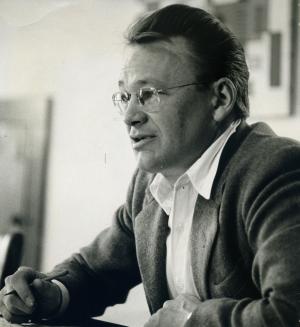 As we were in production, we learned that JOHN ROBINSON, who taught philosophy at Marlboro from 1958 to 1969, died in November 2015. According to Tom Tucker ’71, “John’s style was Socratic: lots of questions, class discussion, and a paper or two every term. He was a taskmaster with a steely glint of humor and a Cheshire Cat–like grin. I was hopeless but enthralled.” Tom stayed in touch with John over the years, and enjoyed a visit from him in Oregon a few years ago. “John’s interest in the natural world was unabated, and his appreciation for Powell’s Books, here in Portland, took on weighty proportions. I count myself lucky to have come under his careful and reasoned approach to thinking, thinking about thinking, writing about thinking, and using a pragmatic point of view to lubricate the gears of seemingly opposed mental engines. John was a solid bulwark in my Marlboro College education and my life as a teacher.”
As we were in production, we learned that JOHN ROBINSON, who taught philosophy at Marlboro from 1958 to 1969, died in November 2015. According to Tom Tucker ’71, “John’s style was Socratic: lots of questions, class discussion, and a paper or two every term. He was a taskmaster with a steely glint of humor and a Cheshire Cat–like grin. I was hopeless but enthralled.” Tom stayed in touch with John over the years, and enjoyed a visit from him in Oregon a few years ago. “John’s interest in the natural world was unabated, and his appreciation for Powell’s Books, here in Portland, took on weighty proportions. I count myself lucky to have come under his careful and reasoned approach to thinking, thinking about thinking, writing about thinking, and using a pragmatic point of view to lubricate the gears of seemingly opposed mental engines. John was a solid bulwark in my Marlboro College education and my life as a teacher.”
Book Shelf
“The reality of sustaining large, open spaces is that they are much more than the sum of their parts. The term open spaces, as I use it here, is intended to invoke not only the challenge of physical size but also of time, ecology, culture, and all elements therein. This is a fundamentally different approach to science that reconceptualizes both problems and solutions to generate more timely and effective means of addressing the vast conservation challenges we face today.”
– Charles Curtin, The Science of Open Spaces
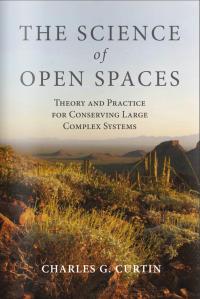 The Science of Open Spaces: Theory and Practice for Conserving Large, Complex Systems (Island Press, ISBN 978-1597269933) turns conventional conservation paradigms on their heads. Based on his decades of experience ranging from the arid Southwest to the north Pacific, Charles Curtin ’86 proposes a new way of thinking about complex natural systems that builds on the fundamental physical laws of the universe and creates innovative conservation from the ground up.
The Science of Open Spaces: Theory and Practice for Conserving Large, Complex Systems (Island Press, ISBN 978-1597269933) turns conventional conservation paradigms on their heads. Based on his decades of experience ranging from the arid Southwest to the north Pacific, Charles Curtin ’86 proposes a new way of thinking about complex natural systems that builds on the fundamental physical laws of the universe and creates innovative conservation from the ground up.
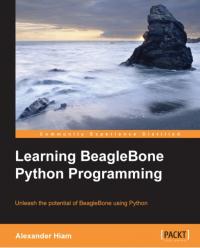 Learning BeagleBone Python Programming (Packt Publishing, ISBN 978-1784399702), by Alexander Hiam ’13, is a user’s guide for the innovative, bare-bones computer curiously named BeagleBone. Alex walks readers through the basics of installing and programming the unit, then dives deeper into BeagleBone’s subsystems and more complex built-in peripherals, demonstrating different ways to receive input, including buttons, sensors, potentiometers, and rotary encoders—a practical guide for any self-respecting geek.
Learning BeagleBone Python Programming (Packt Publishing, ISBN 978-1784399702), by Alexander Hiam ’13, is a user’s guide for the innovative, bare-bones computer curiously named BeagleBone. Alex walks readers through the basics of installing and programming the unit, then dives deeper into BeagleBone’s subsystems and more complex built-in peripherals, demonstrating different ways to receive input, including buttons, sensors, potentiometers, and rotary encoders—a practical guide for any self-respecting geek.
 Foreign Opera at the London Playhouses, from Mozart to Bellini (Cambridge University Press, ISBN 978-1107022218) is the culmination of years of research by author Christina Fuhrmann ’92, a professor of music at Ashland University. She explores how 19th-century operas by foreign composers were adapted for London playhouses, often appearing in drastically altered forms that were integral to the transformation of London’s theatrical and musical life.
Foreign Opera at the London Playhouses, from Mozart to Bellini (Cambridge University Press, ISBN 978-1107022218) is the culmination of years of research by author Christina Fuhrmann ’92, a professor of music at Ashland University. She explores how 19th-century operas by foreign composers were adapted for London playhouses, often appearing in drastically altered forms that were integral to the transformation of London’s theatrical and musical life.
 Oracle (W. W. Norton & Company, ISBN 978-0393077988) is the latest collection of poems from Cate Marvin ’93. Publisher’s Weekly calls Cate’s poems “spectral, charged…a wild, ferocious bunch capable of emotional darkness, bound by a strong poetic ‘I’… a successful call to arms.” The speakers of Oracle occupy the outer-borough cityscape of New York’s Staten Island, where they move through worlds glittering with refuse and peopled by ghosts.
Oracle (W. W. Norton & Company, ISBN 978-0393077988) is the latest collection of poems from Cate Marvin ’93. Publisher’s Weekly calls Cate’s poems “spectral, charged…a wild, ferocious bunch capable of emotional darkness, bound by a strong poetic ‘I’… a successful call to arms.” The speakers of Oracle occupy the outer-borough cityscape of New York’s Staten Island, where they move through worlds glittering with refuse and peopled by ghosts.
 Missing History: The Covert Education of a Child of the Great Books (Threshold Way Publishing, ISBN 978-0996139106) is an intellectual autobiography in the tradition of St. Augustine’s Confessions. Middlebury professor Kathryn Kramer ’75 revisits her school years to figure out how she was indoctrinated into this classic journey. A recurring presence is Katie’s father and former Marlboro professor Corky Kramer. (See an excerpt in Potash Hill, Summer 2011.)
Missing History: The Covert Education of a Child of the Great Books (Threshold Way Publishing, ISBN 978-0996139106) is an intellectual autobiography in the tradition of St. Augustine’s Confessions. Middlebury professor Kathryn Kramer ’75 revisits her school years to figure out how she was indoctrinated into this classic journey. A recurring presence is Katie’s father and former Marlboro professor Corky Kramer. (See an excerpt in Potash Hill, Summer 2011.)
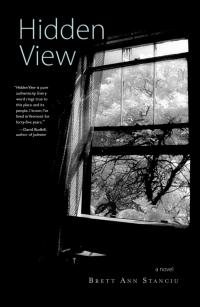 Hidden View (Green Writers Press, ISBN 978-0996135702), by Brett Ann Stanciu ’90, is a novel of stark and raw beauty set in the Vermont agrarian landscape. Deeply rooted in the day-to-day realities of life and work on a hardscrabble farm, of ill-fated love and obsession, Brett’s book offers a decidedly realistic view of the inner lives of a young farming family and their financial and emotional struggles.
Hidden View (Green Writers Press, ISBN 978-0996135702), by Brett Ann Stanciu ’90, is a novel of stark and raw beauty set in the Vermont agrarian landscape. Deeply rooted in the day-to-day realities of life and work on a hardscrabble farm, of ill-fated love and obsession, Brett’s book offers a decidedly realistic view of the inner lives of a young farming family and their financial and emotional struggles.
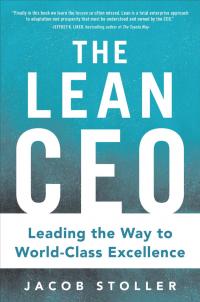 The Lean CEO: Leading the Way to World-Class Excellence (McGraw-Hill Education, ISBN 978-0071833066), by Jacob Stoller ’73, is an instructive primer based on interviews with an all-star cast of business leaders. Although the methodology is decades old, The Lean CEO reveals the true power of “Lean” through in-depth interviews with CEOs who have gone beyond tool adoption and established the methodology as a corporate-wide management system.
The Lean CEO: Leading the Way to World-Class Excellence (McGraw-Hill Education, ISBN 978-0071833066), by Jacob Stoller ’73, is an instructive primer based on interviews with an all-star cast of business leaders. Although the methodology is decades old, The Lean CEO reveals the true power of “Lean” through in-depth interviews with CEOs who have gone beyond tool adoption and established the methodology as a corporate-wide management system.
Magnanimity Cum Laude
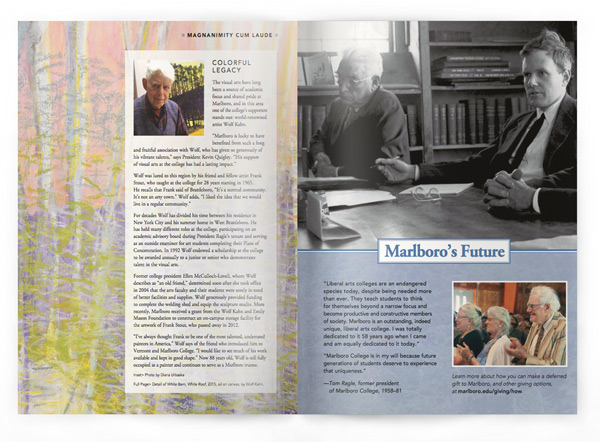
Colorful Legacy
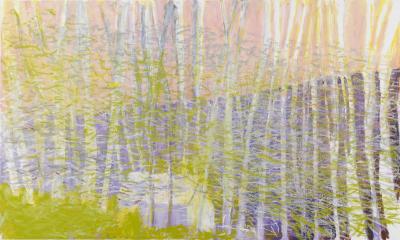 The visual arts have long been a source of academic focus and shared pride at Marlboro, and in this area one of the college’s supporters stands out: world-renowned artist Wolf Kahn.
The visual arts have long been a source of academic focus and shared pride at Marlboro, and in this area one of the college’s supporters stands out: world-renowned artist Wolf Kahn.
“Marlboro is lucky to have benefited from such a long and fruitful association with Wolf, who has given so generously of his vibrant talents,” says President Kevin Quigley. “His support of visual arts at the college has had a lasting impact.”
Wolf was lured to this region by his friend and fellow artist Frank Stout, who taught at the college for 28 years starting in 1965. He recalls that Frank said of Brattleboro, “It’s a normal community. It’s not an arty town.” Wolf adds, “I liked the idea that we would live in a regular community.”
For decades Wolf has divided his time between his residence in New York City and his summer home in West Brattleboro. He has held many different roles at the college, participating on an academic advisory board during President Ragle’s tenure and serving as an outside examiner for art students completing their Plans of Concentration. In 1992 Wolf endowed a scholarship at the college to be awarded annually to a junior or senior who demonstrates talent in the visual arts.
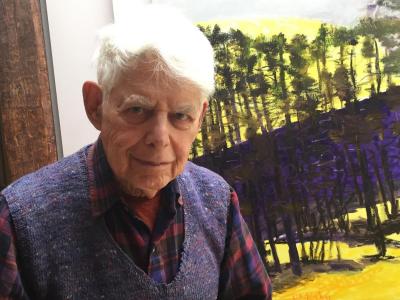 Former college president Ellen McCulloch-Lovell, whom Wolf describes as “an old friend,” determined soon after she took office in 2004 that the arts faculty and their students were sorely in need of better facilities and supplies. Wolf generously provided funding to complete the welding shed and equip the sculpture studio. More recently, Marlboro received a grant from the Wolf Kahn and Emily Mason Foundation to construct an on-campus storage facility for the artwork of Frank Stout, who passed away in 2012.
Former college president Ellen McCulloch-Lovell, whom Wolf describes as “an old friend,” determined soon after she took office in 2004 that the arts faculty and their students were sorely in need of better facilities and supplies. Wolf generously provided funding to complete the welding shed and equip the sculpture studio. More recently, Marlboro received a grant from the Wolf Kahn and Emily Mason Foundation to construct an on-campus storage facility for the artwork of Frank Stout, who passed away in 2012.
“I’ve always thought Frank to be one of the most talented, underrated painters in America,” Wolf says of the friend who introduced him to Vermont and Marlboro College. “I would like to see much of his work available and kept in good shape.” Now 88 years old, Wolf is still fully occupied as a painter and continues to serve as a Marlboro trustee.
Marlboro’s Future
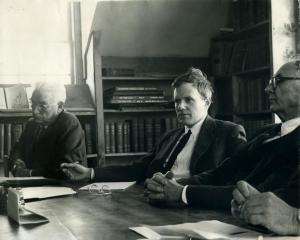 “Liberal arts colleges are an endangered species today, despite being needed more than ever. They teach students to think for themselves beyond a narrow focus and become productive and constructive members of society. Marlboro is an outstanding, indeed unique, liberal arts college. I was totally dedicated to it 58 years ago when I came and am equally dedicated to it today.”
“Liberal arts colleges are an endangered species today, despite being needed more than ever. They teach students to think for themselves beyond a narrow focus and become productive and constructive members of society. Marlboro is an outstanding, indeed unique, liberal arts college. I was totally dedicated to it 58 years ago when I came and am equally dedicated to it today.”
“Marlboro College is in my will because future generations of students deserve to experience that uniqueness.”
— Tom Ragle, former president of Marlboro College, 1958–81
Learn more about how you can make a deferred gift to Marlboro, and other giving options, at marlboro.edu/giving/how.
Special Web Features
The foundation of our experience: An interview with William Edelglass
Sophomore Noah Strauss Jenkins went on a stroll with philosophy professor William Edelglass, on the driveway to his off-grid solar home off South Road, to discuss classes, research projects, life with twin toddlers, and what is so phenomenal about phenomenology.
Noah Strauss Jenkins: So I’m wondering how you’ve seen this semester going, with all of your classes? Are there some that you like more than others?
William Edelglass: Phenomenology is a course I’ve been teaching this semester that I totally love. I am inspired by the material, and it’s really challenging for students. Many of the texts are often taught at the graduate level. I think they are amazingly profound and insightful, and the students are really wonderful. They have been doing their presentations, and I thought they did insightful and excellent work. One of the questions that ran through the phenomenology course was about “what is a subject and how do we relate to others?” and that was of particular interest to some students. So in discussion with that class I decided to teach a class next semester that looks at the history of that question from Descartes through more contemporary thinkers.
NSJ: I guess the natural question would be: what is phenomenology?
WE: Pheno in Greek means to seem or appear. Phenomenology isn’t really a Greek word, but one way of defining it would be to say that it is the study of that which appears. What that means is that it is an approach to thinking about, well, just about anything that begins with the first person experience of whatever it is we’re are talking about. So what does it mean, as opposed to what it is objectively.
NSJ: Okay, I see.
WE: So for example you and I are now walking up this driveway. There are all kinds of ways we could think about this driveway right now: you could look at the chemical elements, you could look at the how deep the sand and gravel foundation goes, you could look at the incline, you could look at the trees on the sides.
NSJ: So how is phenomenology different?
WE: A phenomenological approach might be to start with, well, what does it feel like right now to be walking up, and what is the meaning of it, and mainly what is the meaning of it to me? If I were to measure it and give some mathematical or technical analysis of it, that mathematical analysis would always and necessarily be abstracted from the experience I have. There is no immediate access to the world that is not through our experience. Phenomenology tries to provide an account of the structures and meanings at the foundation of our experience, or the foundation really of any knowledge.
NSJ: Alright, so that’s a pretty wide umbrella. Did you just start doing phenomenology with Aiden Keeva (’15)?
WE: Do you mean teaching it at Marlboro?
NSJ: Yeah.
WE: No I actually taught a course on phenomenology my very first semester here. and I’ve done a regular one every three years or so.
NSJ: That’s awesome.
WE: It’s had different titles at different times
NSJ: So, are you still pursuing your own research as well?
WE: Three or four chapters of my dissertation were written on a phenomenological thinker named Levinas, who I taught for classes this semester and that I will teach some more of next semesters. I also co-wrote a book that addresses how you can use his work in the context of environmental thinking. And I published, I don’t know, six or seven articles or chapters on his work. But I’ve written about other parts of phenomenology as well, like phenomenology and art. Phenomenological thinking has certainly been a big part of my own works, both my scholarship and teaching.
NSJ: I was wondering about the book on apophasis you are writing with Amer? Can you tell me about that?
WE: So Amer and I, with three colleagues at other universities, have been working on this project for a while. It included several conferences one of which was a week-long seminar we held here at my house in May 2015, which included faculty and students from as far away as the University of Hawaii and several Marlboro students as well. One of the faculty colleagues is a specialist on Hindu traditions, one on Jewish traditions, one of Christian traditions, Amer is working on Islam, and I’m working on Buddhism. Part of that project, for which, strangely enough, the foundation gave us $100,000, was to do some public events. These have included a town meeting in Kansas City and working with students—like in the class in Apophatic Discourse you took with Amer and I—but also research trips to India and Pakistan among other places. It also is leading to a collaboratively authored book that we hope to finish in the next five months. We are each writing two chapters: one chapter that is more focused on the tradition, and giving an account of the relation between the apophatic and the cataphatic form within the tradition; and then a second chapter that is more methodological. The second chapter will step back and analyze the work in the first chapter, and look at how the category of the apophatic operates across these different traditions.
NSJ: And who are the three other people involved in the project?
WE: One of them is Aaron Simmons who is a Pentecostal Christian and a very sophisticated philosopher. Another is Martin Shuster, and he working in Judaism. The third is a woman named Sai Bhatawadekar.
NSJ: Cool, okay. And how did you all get to know each other? Is it through this project?
WE: Years ago Aaron contributed a chapter to a book that I was editing and we met… (baby Jasmine (?) wakes up in the stroller) So she’s been asleep…it’s two now?
NSJ: Yeah
WE: So she’s been asleep for something like four hours now, and honestly I was getting worried because she has never napped this long. I was wondering if she was okay. Every once in a while I would loose my train of thought, so do you want to go inside now?
NSJ: Yeah, totally
William: Aaron had me give a talk, he teaches in the south, and there was a talk on climate ethics. At the time it seemed kind of strange to fly all the way down south to give a lecture on global responsibility and climate change, so I used Skype from my office in Marlboro, and it went really well. Since then I’ve had him speak to my class a few times through Skype, and I’ve talked to his class through Skype. He’s taught some of my works, and I’ve taught some of his. So we’ve been professional colleagues for a long time, but we hadn’t met until a year or so ago. We’ve spent a lot of time together; He and his wife and child were up here for a week, and Martin and his wife and child were here for the seminar, and we all got to know each other well. Actually Sai Bhatawadekar, who studies Hinduism and German philosophy, also teaches Bollywood dance, do you know what Bollywood is?
WE: Yeah, definitely
William: So one night she taught us a Bollywood dance routine, which was so much fun, and then we performed it the next morning before the ending ceremonies. And as it happens I’ve seen a couple of them at various conferences since then.
NSJ: That’s awesome. Has it been harder this semester with the kids?
WE: Totally, I mean I get very little sleep, and there are a few other things that I’m writing. I gave a couple papers; you remember I had to travel out of town for a week or so.
NSJ: Yeah, yeah
WE: Prior to the girls being born I used to be co-director to the International Association of Human Philosophy, which is an international philosophy organization with members in five continents; last year I was in charge of the big conference in New Orleans. So I had a whole bunch more professional responsibilities, but even shedding that, my life is completely different. So I’m not playing soccer this year, and getting very little sleep. But in addition to the collaborative book project I am writing something on Buddhism and poetry. There’s actually a Marlboro graduate named Nahum Brown who completed a PhD in philosophy working on Hegel and Deleuze, and he is putting together a book. Do you remember the guy who edited the book that we used in the Apophatic Discourse class you took, William Franke?
NSJ: Yeah, of course.
WE: So, he is a professor at Vanderbilt, and in Macau in China, and Nahum has been working with Franke in China the last year and a half, and they actually wanted me to co-edit a book with Nahum on Franke’s work in apophaticism. But I didn’t have time for that with the girls. However I am writing something on W. S. Merwin and Gary Snyder, two contemporary Buddhist poets, and I’m teaching a workshop at the Barre Center for Buddhist studies on Buddhism and poetry. The Barre Center for Buddhist Studies is a place where people send academic work, it’s a really wonderful place to teach. I taught a workshop there earlier this summer and loved it. Actually my best friend from college and I—he’s a meditation teacher—we’ve agreed to teach a week long seminar there every year
NSJ: Oh wow. And wait, where is that?
WE: It’s in Barre, Massachusetts. And there are three other lectures that I’ve committed to in the spring so I’ve got my hands full, but I really love that part of life. I just agreed to teach, as a part of a seminar with grad students and faculty, in Sitka, Alaska for a couple weeks this summer. We’re all going, Kirstin and the girls and Kirstin’s mother.
NSJ: that’s awesome! And what are you teaching out there?
WE: Well I haven’t really decided yet, but it may be something on embodied practices on the landscape in Himalayan peoples. I’m working it out with the organizers. Did you read Spell of the Sensuous, by David Abram?
NSJ: I read the beginning of it.
WE: There’s a guy who is mentioned a lot in Spell of the Sensuous named Richard Nelson, who’s the foremost Tlingit anthropologist. Tlingit is the native Alaskan group in the inner passage area around Sitka, where we are going to be. He is actually going to be teaching as well.
NSJ: So what are the other papers you are working on right now?
WE: So one is on the apophatic tradition in Buddhism in India, Tibet, and little bit in China. Another is thinking about negation and positivity in those traditions, that’s the more methodological chapter where I’m looking at the question of language in the apophatic of these two poets Merwin and Snyder. And I’m giving a talk at Smith College, as part of their Buddhist studies series in February, on Buddhism and happiness. I was asked to give a talk at the Rochester Institute of Technology on Bhutan and Buddhism and happiness. I don’t know if you know about…
NSJ: I know about the national happiness index, what is it called?
WE: The gross national happiness index. Yeah, so I’m going to give a talk related to that. I don’t know if I’m going to do this but I agreed to give a talk on Buddhism and painting, Buddhism and art, at a conference at the Barre Center of Buddhist Studies. There’s the guy who was here, Steven Batchelor, and four other people who will be doing presentations of Buddhism and art, but I don’t know if I’m actually going to do it. So those are some of the things.
NSJ: That’s a fair amount of stuff. What classes are you teaching next semester? There’s the genealogy of race and then what?
WE: Yeah, there’s the Genealogy of Race, and then a class called Selves and Others.
NSJ: and that’s the phenomenology class?
WE: Well there’s a lot that is prior to phenomenology but it’s going to end with two phenomenological thinkers.
NSJ: That’s cool.
WE: It will include people like Kant and Heidegger and Husserl and Hegel and Hobbes—all the big H’s—and Kierkegaard
NSJ: I took the Kant’s Critic of Pure Reason class last semester.
WE: Was it primarily on the Critic of Pure Reason?
NSJ: Yeah, that was the main thing. It was pretty crazy, I had a really rough time with it until the end but it was really rewarding. Casey Ford (philosophy fellow during William’s sabbatical) was a good teacher.
WE: Yeah he seemed like a great teacher.
NSJ: How are the classes finishing up this semester? I know ours is going pretty well (Seminar in Religion, Literature, and Philosophy).
WE: I really enjoyed the small class, the smallest class I ever taught. Being able to all sit in my office and drink tea, I’ve really enjoyed it. It’s also the case that it’s very hard to hide if you’re a student, like if you’re in a class of 25 and you don’t do the reading nobody cares, but if somebody doesn’t do the reading in our class everybody knows it.
NSJ: It’s true
WE: Which is okay. There’s a kind of vulnerability, but since it’s kind of small and everybody knows each other so well I feel like there’s no competition.
NSJ: Yeah, I really like it. I think it’s a very safe place to be confused.
WE: The phenomenology class is a little bit different in that respect. It’s got a wide range of students with regards to background in philosophy, and it’s just very hard material and doesn’t have quite as relaxed a feel. But I’ve been very impressed with the presentations people have been doing and I’m reading the drafts of papers now and I’ve enjoyed it.
NSJ: What was the final paper supposed to be about?
WE: Whatever they wanted—there’s a wide range. One paper is on disabled bodies and using one of the phenomenological analyses we read to apply to disabled bodies. Another is the experience of looking at a photograph and photography. Another is on mental images and cognitive science and models of thinking about things in human experience. One of them is about two poems by Elizabeth Bishop and a poem by Emily Dickinson that demonstrates the phenomenological dimension of their work in those poems. Phenomenology can also be something that happens in poetry, not just philosophy. Then several of the papers are primarily interpretative and trying to give an account of one or a few of the texts we’ve read.
NSJ: Yeah, I have to write a 15-page paper about the changes in Dorothea in Middlemarch by George Eliot.
WE: Was the topic assigned?
NSJ: No I chose it, it’s for Realism to Modernism that Geraldine is teaching
WE: How is the paper going?
NSJ: Not great. I really loved the class; it was just very challenging. I’m a very slow reader and there was a lot of reading. But I’m excited about it. I really liked Middlemarch—it was amazing.
WE: It’s a great book. David Abram was saying that he is a very slow reader.
NSJ: Yeah, my mom always said that I would get faster at it, but it hasn’t really worked out that way.
WE: It’s ok to be a slow reader, but I suppose it makes things harder at times. It’s only helpful to be a fast reader when what you are reading isn’t really worth reading. Like I just read a book on sleep for children, and I was just skimming through it, but when I read philosophy I usually read very slowly.